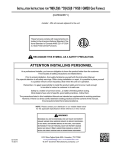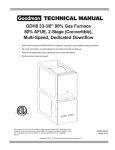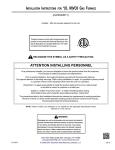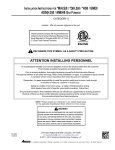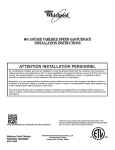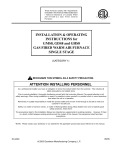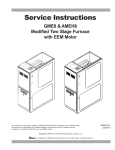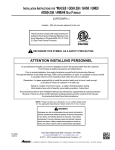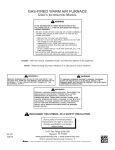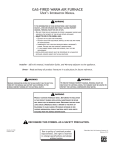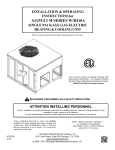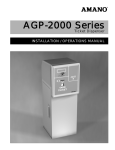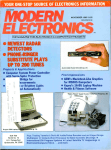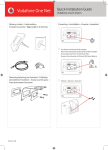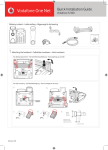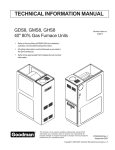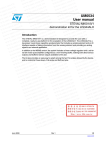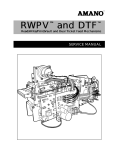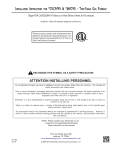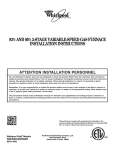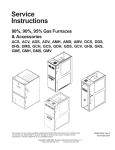Download m(h,s)8 / *d(h,s)8 / *hs8 / gme8 gas furnace
Transcript
INSTALLATION INSTRUCTIONS FOR *M(H,S)8 / *D(H,S)8 / *HS8 / GME8 GAS FURNACE (CATEGORY I ) Installer: Affix all manuals adjacent to the unit. These furnaces comply with requirements embodied in the American National Standard / National Standard of Canada ANSI Z21.47·CSA2.3 Gas Fired Central Furnaces. RECOGNIZE THIS SYMBOL AS A SAFETY PRECAUTION. ATTENTION INSTALLING PERSONNEL As a professional installer, you have an obligation to know the product better than the customer. This includes all safety precautions and related items. Prior to actual installation, thoroughly familiarize yourself with this Instruction Manual. Pay special attention to all safety warnings. Often during installation or repair, it is possible to place yourself in a position which is more hazardous than when the unit is in operation. Remember, it is your responsibility to install the product safely and to know it well enough to be able to instruct a customer in its safe use. Safety is a matter of common sense...a matter of thinking before acting. Most dealers have a list of specific, good safety practices...follow them. The precautions listed in this Installation Manual are intended as supplemental to existing practices. However, if there is a direct conflict between existing practices and the content of this manual, the precautions listed here take precedence. NOTE: Please contact your distributor or our website listed below for the applicable Specification Sheet referred to in this manual. WARNING GOODMAN WILL NOT BE RESPONSIBLE FOR ANY INJURY OR PROPERTY DAMAGE ARISING FROM IMPROPER SERVICE OR SERVICE PROCEDURES. IF YOU INSTALL OR PERFORM SERVICE ON THIS UNIT, YOU ASSUME RESPONSIBILITY FOR ANY PERSONAL INJURY OR PROPERTY DAMAGE WHICH MAY RESULT. MANY JURISDICTIONS REQUIRE A LICENSE TO INSTALL OR SERVICE HEATING AND AIR CONDITIONING EQUIPMENT. IO-417B 10/2012 5151 San Felipe Suite 500 • Houston, TX 77056 www.goodmanmfg.com • www.amana-hac.com © 2011 - 2012 Goodman Manufacturing Company, L.P. Table of Contents SAFETY PRECAUTIONS .......................................................................................................................... 5 ADDITIONAL SAFETY CONSIDERATIONS ...................................................................................................... 6 SHIPPING INSPECTION ........................................................................................................................... 6 ELECTROSTATIC DISCHARGE (ESD) PRECAUTIONS ..................................................................................... 6 TO THE INSTALLER .............................................................................................................................. 6 IMPORTANT NOTE TO THE OWNER REGARDING PRODUCT WARRANTY ................................................................. 6 PRODUCT APPLICATION ............................................................................................................................... 7 LOCATION REQUIREMENTS AND CONSIDERATIONS ................................................................................................ 8 CLEARANCES AND ACCESSIBILITY ............................................................................................................ 9 INSTALLATION POSITIONS ...................................................................................................................... 9 HORIZONTAL INSTALLATION .................................................................................................................... 9 FURNACE SUSPENSION ........................................................................................................................ 10 EXISTING FURNACE REMOVAL .............................................................................................................. 10 THERMOSTAT LOCATION ...................................................................................................................... 10 COMBUSTION AND VENTILATION AIR REQUIREMENTS .......................................................................................... 10 CATEGORY I VENTING (VERTICAL VENTING) ..................................................................................................... 11 EXTERIOR MASONRY CHIMNEYS (CATEGORY I FURNACES ONLY) ......................................................................... 12 CHECKLIST SUMMARY ........................................................................................................................ 12 CHECK 1 - PROPER CHIMNEY TERMINATION. ............................................................................................. 13 CHECK 2 - ANY SOLID OR LIQUID FUEL APPLIANCES VENTED INTO THIS CHIMNEY CHANNEL ...................................... 14 CHECK 3 - CHIMNEY CROWN CONDITION. ................................................................................................ 14 CHECK 4 - DEBRIS IN CLEANOUT .......................................................................................................... 14 CHECK 5 - LINER CONDITION. ............................................................................................................... 14 CHECK 6 - DILUTION AIR. ................................................................................................................... 14 CHECK 7 - COMPLETE THE INSTALLATION. ............................................................................................... 15 FIX 1 - LINER TERMINATION ................................................................................................................. 15 FIX 2 -CHANGE VENTING ARRANGEMENTS ............................................................................................... 15 FIX 3 - REBUILD THE CROWN ............................................................................................................... 15 FIX 4 - RELINING .............................................................................................................................. 15 ELECTRICAL CONNECTIONS ........................................................................................................................ 16 WIRING HARNESS .............................................................................................................................. 16 115 VOLT LINE CONNECTIONS ............................................................................................................. 16 FOSSIL FUEL APPLICATIONS ................................................................................................................ 16 JUNCTION BOX RELOCATION ................................................................................................................ 17 24 VOLT THERMOSTAT WIRING ............................................................................................................ 17 GME8 FURNACE WITH 2-STAGE CONDENSER FIELD WIRING ....................................................................... 17 SETTING THE HEAT ANTICIPATOR ........................................................................................................... 18 115 VOLT LINE CONNECTION OF ACCESSORIES ........................................................................................ 18 (ELECTRONIC AIR CLEANER) ................................................................................................................ 18 24 VAC HUMIDIFIER .......................................................................................................................... 19 GAS SUPPLY AND PIPING ........................................................................................................................... 19 HIGH ALTITUDE DERATE ...................................................................................................................... 19 PROPANE GAS CONVERSION ................................................................................................................ 19 GAS PIPING CONNECTIONS .................................................................................................................. 20 UPFLOW INSTALLATIONS ..................................................................................................................... 21 COUNTERFLOW INSTALLATIONS .............................................................................................................. 21 GAS PIPING CHECKS ......................................................................................................................... 21 PROPANE GAS TANKS AND PIPING ......................................................................................................... 21 2 Table of Contents CIRCULATING AIR AND FILTERS .................................................................................................................... 22 DUCTWORK - AIR FLOW ...................................................................................................................... 22 CHECKING DUCT STATIC ..................................................................................................................... 23 FILTERS - READ THIS SECTION BEFORE INSTALLING THE RETURN AIR DUCTWORK ............................................ 23 UPRIGHT INSTALLATIONS ..................................................................................................................... 23 CIRCULATION AIR FILTERS ................................................................................................................... 23 HORIZONTAL INSTALLATIONS ................................................................................................................ 24 SEQUENCE OF OPERATION (INTEGRATED IGNITION CONTROL) ................................................................................ 24 POWER UP ...................................................................................................................................... 24 HEATING MODE ................................................................................................................................. 24 (MODE DIP SWITCH IS SET TO “1 STG” POSITION) .................................................................................. 24 (MODE DIP SWITCH IS SET TO “2 STG” POSITION) ................................................................................. 24 COOLING MODE ................................................................................................................................ 25 FAN ONLY MODE .............................................................................................................................. 25 START-UP PROCEDURE AND ADJUSTMENT ....................................................................................................... 25 FURNACE OPERATION .......................................................................................................................... 25 FURNACE START-UP ........................................................................................................................... 25 FURNACE SHUTDOWN ......................................................................................................................... 25 GAS SUPPLY PRESSURE MEASUREMENT .................................................................................................. 26 GAS MANIFOLD PRESSURE MEASUREMENT AND ADJUSTMENT ....................................................................... 28 GAS INPUT RATE MEASUREMENT (NATURAL GAS ONLY) ............................................................................ 29 TEMPERATURE RISE ........................................................................................................................... 29 CIRCULATOR BLOWER SPEED ADJUSTMENT ............................................................................................. 30 CIRCULATOR BLOWER FAN TIMING ADJUSTMENT ...................................................................................... 30 SETTING FURNACE OPERATING MODE (*DH8, *ME8, AND *MH8 MODELS ONLY) ............................................ 30 OPERATIONAL CHECKS .............................................................................................................................. 31 BURNER FLAME ................................................................................................................................ 31 AUXILIARY LIMIT CONTROL ................................................................................................................. 31 SAFETY CIRCUIT DESCRIPTION .................................................................................................................... 31 GENERAL ......................................................................................................................................... 31 INTEGRATED CONTROL MODULE ............................................................................................................. 31 PRIMARY LIMIT ................................................................................................................................ 31 AUXILIARY LIMIT ............................................................................................................................... 31 ROLLOUT LIMITS .............................................................................................................................. 31 PRESSURE SWITCHES ......................................................................................................................... 32 FLAME SENSOR ................................................................................................................................ 32 TROUBLESHOOTING ................................................................................................................................... 32 ELECTROSTATIC DISCHARGE (ESD) PRECAUTIONS ................................................................................... 32 DIAGNOSTIC CHART ........................................................................................................................... 32 FAULT RECALL ................................................................................................................................ 32 RESETTING FROM LOCKOUT ................................................................................................................ 32 3 Table of Contents MAINTENANCE ......................................................................................................................................... ANNUAL INSPECTION ........................................................................................................................... FILTERS .......................................................................................................................................... FILTER MAINTENANCE ......................................................................................................................... FILTER REMOVAL .............................................................................................................................. INDUCED DRAFT AND CIRCULATOR BLOWER MOTORS ................................................................................. FLAME SENSOR (QUALIFIED SERVICER ONLY) .......................................................................................... IGNITER (QUALIFIED SERVICER ONLY) ..................................................................................................... BURNERS ......................................................................................................................................... CLEANING (QUALIFIED SERVICER ONLY) ........................................................................................................ BEFORE LEAVING AN INSTALLATION ............................................................................................................... REPAIR AND REPLACEMENT PARTS .............................................................................................................. COMPONENT ID ................................................................................................................................ COMPONENT ID ................................................................................................................................ TROUBLESHOOTING CHART .................................................................................................................. APPENDIX ............................................................................................................................................... TROUBLESHOOTING CHART .................................................................................................................. TROUBLESHOOTING CHART .................................................................................................................. TROUBLESHOOTING CHART .................................................................................................................. BLOWER PERFORMANCE DATA ............................................................................................................. *M(H/S)8 ................................................................................................................................. *(D/H)S8 ................................................................................................................................. BLOWER PERFORMANCE DATA ............................................................................................................. GME8 ..................................................................................................................................... WIRING DIAGRAMS ............................................................................................................................ *(M, D, H)S8 WIRING DIAGRAM .................................................................................................. GME8 WIRING DIAGRAM ............................................................................................................ *(M,D)H8 WIRING DIAGRAM ....................................................................................................... 4 32 32 33 33 33 33 33 33 33 33 34 34 35 36 37 37 37 38 39 40 40 41 42 42 43 43 44 45 SAFETY PRECAUTIONS Adhere to the following warnings and cautions when installing, adjusting, altering, servicing, or operating the furnace. To ensure proper installation and operation, thoroughly read this manual for specifics pertaining to the installation and application of this product. WARNING TO PREVENT PERSONAL INJURY OR DEATH DUE TO IMPROPER INSTALLATION, ADJUSTMENT, ALTERATION, SERVICE OR MAINTENANCE, REFER TO THIS MANUAL . FOR ADDITIONAL ASSISTANCE OR INFORMATION, CONSULT A QUALIFIED INSTALLER, SERVICER AGENCY OR THE GAS SUPPLIER. WARNING IF THE INFORMATION IN THESE INSTRUCTIONS IS NOT FOLLOWED EXACTLY, A FIRE OR EXPLOSION MAY RESULT CAUSING PROPERTY DAMAGE , PERSONAL INJURY OR LOSS OF LIFE. DO NOT STORE OR USE GASOLINE OR OTHER FLAMMABLE VAPORS AND LIQUIDS IN THE VICINITY OF THIS OR ANY OTHER APPLIANCE. WHAT TO DO IF YOU SMELL GAS: DO NOT TRY TO LIGHT ANY APPLIANCE. DO NOT TOUCH ANY ELECTRICAL SWITCH; DO NOT USE ANY PHONE IN YOUR BUILDING. IMMEDIATELY CALL YOUR GAS SUPPLIER FROM A NEIGHBOR’S PHONE. FOLLOW THE GAS SUPPLIER’S INSTRUCTIONS. IF YOU CANNOT REACH YOUR GAS SUPPLIER, CALL THE FIRE DEPARTMENT. INSTALLATION AND SERVICE MUST BE PERFORMED BY A QUALIFIED INSTALLER, SERVICE AGENCY OR THE GAS SUPPLIER. CARBON MONOXIDE POISONING HAZARD Special Warning for Installation of Furnace or Air Handling Units in Enclosed Areas such as Garages, Utility Rooms or Parking Areas Carbon monoxide producing devices (such as an automobile, space heater, gas water heater, etc.) should not be operated in enclosed areas such as unventilated garages, utility rooms or parking areas because of the danger of carbon monoxide (CO) poisoning resulting from the exhaust emissions. If a furnace or air handler is installed in an enclosed area such as a garage, utility room or parking area and a carbon monoxide producing device is operated therein, there must be adequate, direct outside ventilation. This ventilation is necessary to avoid the danger of CO poisoning which can occur if a carbon monoxide producing device continues to operate in the enclosed area. Carbon monoxide emissions can be (re)circulated throughout the structure if the furnace or air handler is operating in any mode. WARNING CO can cause serious illness including permanent brain damage or death. THIS PRODUCT CONTAINS OR PRODUCES A CHEMICAL OR CHEMICALS WHICH MAY CAUSE SERIOUS ILLNESS OR DEATH AND WHICH ARE KNOWN TO THE STATE OF CALIFORNIA TO CAUSE CANCER, BIRTH DEFECTS OR OTHER REPRODUCTIVE HARM. B10259-216 WARNING SHOULD OVERHEATING OCCUR OR THE GAS SUPPLY FAIL TO SHUT OFF, TURN OFF THE MANUAL GAS SHUTOFF VALVE EXTERNAL TO THE FURNACE BEFORE TURNING OFF THE ELECTRICAL SUPPLY. WARNING HEATING UNIT SHOULD NOT BE UTILIZED WITHOUT REASONABLE, ROUTINE, INSPECTION , MAINTENANCE AND SUPERVISION. IF THE BUILDING IN WHICH ANY SUCH DEVICE IS LOCATED WILL BE VACANT, CARE SHOULD BE TAKEN THAT SUCH DEVICE IS ROUTINELY INSPECTED, MAINTAINED AND MONITORED. IN THE EVENT THAT THE BUILDING MAYBE EXPOSED TO FREEZING TEMPERATURES AND WILL BE VACANT, ALL WATER‐BEARING PIPES SHOULD BE DRAINED, THE BUILDING SHOULD BE PROPERLY WINTERIZED, AND THE WATER SOURCE CLOSED . IN THE EVENT THAT THE BUILDING MAY BE EXPOSED TO FREEZING TEMPERATURES AND WILL BE VACANT, ANY HYDRONIC COIL UNITS SHOULD BE DRAINED AS WELL AND, IN SUCH CASE , ALTERNATIVE HEAT SOURCES SHOULD BE UTILIZED. WARNING POSSIBLE PROPERTY DAMAGE, PERSONAL INJURY OR DEATH DUE TO FIRE, EXPLOSION, SMOKE, SOOT, CONDENSATION, ELECTRICAL SHOCK OR CARBON MONOXIDE MAY RESULT FROM IMPROPER INSTALLATION, REPAIR OPERATION, OR MAINTENANCE OF THIS PRODUCT. WARNING TO PREVENT PERSONAL INJURY OR DEATH DUE TO IMPROPER INSTALLATION, ADJUSTMENT, ALTERATION, SERVICE OR MAINTENANCE, REFER TO THIS MANUAL . FOR ADDITIONAL ASSISTANCE OR INFORMATION, CONSULT A QUALIFIED INSTALLER, SERVICER AGENCY OR THE GAS SUPPLIER. WARNING TO PREVENT POSSIBLE PROPERTY DAMAGE, PERSONAL INJURY OR DEATH DUE TO ELECTRICAL SHOCK , THE FURNACE MUST BE LOCATED TO PROTECT THE ELECTRICAL COMPONENTS FROM WATER. 5 This procedure is applicable to both installed and non-installed (ungrounded) furnaces. 1. Disconnect all power to the furnace. Do not touch the TO PREVENT PERSONAL INJURY OR DEATH DUE TO ASPHYXIATION, THIS integrated control module or any wire connected to the FURNACE MUST BE CATEGORY I VENTED. DO NOT VENT USING control prior to discharging your body’s electrostatic CATEGORY III VENTING. charge to ground. PROVISIONS MUST BE MADE FOR VENTING COMBUSTION PRODUCTS 2. Firmly touch a clean, unpainted, metal surface of the OUTDOORS THROUGH A PROPER VENTING SYSTEM. THE LENGTH OF furnaces near the control. Any tools held in a person’s FLUE PIPE COULD BE A LIMITING FACTOR IN LOCATING THE FURNACE. hand during grounding will be discharged. ADDITIONAL SAFETY CONSIDERATIONS 3. Service integrated control module or connecting wiring • This furnace is approved for Category I Venting only. following the discharge process in step 2. Use caution • Provisions must be made for venting combustion not to recharge your body with static electricity; (i.e., do products outdoors through a proper venting system. not move or shuffle your feet, do not touch ungrounded The length of flue pipe could be a limiting factor in objects, etc.). If you come in contact with an ungrounded locating the furnace. object, repeat step 2 before touching control or wires. 4. Discharge your body to ground before removing a new SHIPPING INSPECTION control from its container. Follow steps 1 through 3 if installing the control on a furnace. Return any old or All units are securely packed in shipping containers tested new controls to their containers before touching any according to International Safe Transit Association specificaungrounded object. tions. The carton must be checked upon arrival for external damage. If damage is found, a request for inspection by carrier’s TO THE INSTALLER agent must be made in writing immediately. The furnace must be carefully inspected on arrival for damage Before installing this unit, please read this manual thoroughly and bolts or screws which may have come loose in transit. In to familiarize yourself with specific items which must be adhered to, including but not limited to: unit maximum external the event of damage the consignee should: static pressure, gas pressures, BTU input rating, proper elec1. Make a notation on delivery receipt of any visible damage trical connections, circulating air temperature rise, minimum or to shipment or container. maximum CFM, and motor speed connections, and venting. 2. Notify carrier promptly and request an inspection. These furnaces are designed for Category I venting only. 3. With concealed damage, carrier must be notified as soon as possible - preferably within five days. WARNING 4. File the claim with the following support documents within TO PREVENT PROPERTY DAMAGE, PERSONAL INJURY OR DEATH DUE TO a nine month statute of limitations. FIRE, DO NOT INSTALL THIS FURNACE IN A MOBILE HOME, TRAILER, OR • Original or certified copy of the Bill of Lading, or RECREATIONAL VEHICLE. indemnity bond. • Original paid freight bill or indemnity in lieu thereof. IMPORTANT NOTE TO THE OWNER REGARDING PRODUCT • Original or certified copy of the invoice, showing trade WARRANTY and other discounts or reductions. Your warranty certificate is supplied as a separate document • Copy of the inspection report issued by carrier’s with the unit installed by your contractor. Read the limited warrepresentative at the time damage is reported to carrier. ranty certificate carefully to determine what is and is not covThe carrier is responsible for making prompt inspection of dam- ered and keep the warranty certificate in a safe place. If you are age and for a thorough investigation of each claim. The distribu- unable to locate the warranty certificate please contact your tor or manufacturer will not accept claims from dealers for trans- installing contractor or contact customer service (877-254-4729) portation damage. to obtain a copy. WARNING Keep this literature in a safe place for future reference. IMPORTANT: To receive the Lifetime Heat Exchanger Limited Warranty (good for as long as you own your home) and the 10ELECTROSTATIC DISCHARGE (ESD) PRECAUTIONS year Parts Limited Warranty, online registration must be comNOTE: Discharge body’s static electricity before touching unit. pleted within 60 days of installation. Online registration is not An electrostatic discharge can adversely affect electrical com- required in California or Quebec. Complete warranty details available from your local dealer or, for Goodman® brand prodponents. ucts, visit www.goodmanmfg.com, and for Amana® brand prodUse the following precautions during furnace installation and ucts, visit www.amana-hac.com. servicing to protect the integrated control module from damage. By putting the furnace, the control, and the person at the same electrostatic potential, these steps will help avoid exposing the integrated control module to electrostatic discharge. 6 To register your Goodman ® brand unit, go to www.goodmanmfg.com and click “Warranty Registration”. Complete the registration as prompted. • To register your Amana® brand unit, go to www.amana-hac.com and click “Warranty Registration”. Complete the registration as prompted. • • Product limited warranty certificates for models currently in production can be viewed at www.goodmanmfg.com or www.amanahac.com. If your model is not currently in production or does not appear on the website, please contact your installing contractor or contact customer service (877-254-4729) to obtain a copy of your warranty certificate. • Each product overview page contains a Product Warranty link; by clicking on it you will be able to view the limited warranty coverage for that specific product. To view warranty registration information, click on the Product Warranty text on the left navigation panel on the home page of each website. The Online Product Registration pages are located in this same section. • PRODUCT APPLICATION Air filters are installed in the system and maintained during construction, replaced as appropriate during construction, and upon completion of construction are replaced. The input rate and temperature rise are set per the furnace rating plate. 100% outside air is provided for combustion air requirements during construction. Temporary ducting can be used. NOTE: Do not connect the temporary duct directly to the furnace. The duct must be sized according to the instructions under Combustion and Ventilation Air Requirements, Section 5.3.3. The furnace heat exchanger, components, duct system, air filters and evaporator coils are thoroughly cleaned following final construction clean up. All furnace operating conditions (including ignition, input rate, temperature rise and venting) are verified according to these installation instructions. NOTE: The Commonwealth of Massachusetts requires that the following additional requirements must also be met: This furnace is primarily designed for residential home-heating applications. It is NOT designed or certified for use in mobile homes, trailers or recreational vehicles. Neither is it designed or certified for outdoor applications. The furnace must be installed indoors (i.e., attic space, crawl space, or garage area provided the garage area is enclosed with an operating door). • • • This furnace can be used in the following non-industrial commercial applications: Schools, Office buildings, Churches, Retail stores, Nursing homes, Hotels/motels, Common or office areas Gas furnaces must be installed by a licensed plumber or gas fitter. A T-handle gas cock must be used. If the unit is to be installed in an attic, the passageway to and the service area around the unit must have flooring. WARNING TO PREVENT PROPERTY DAMAGE, PERSONAL INJURY OR DEATH DUE TO FIRE, DO NOT INSTALL THIS FURNACE IN A MOBILE HOME, TRAILER, OR RECREATIONAL VEHICLE. In such applications , the furnace must be installed with the following stipulations: • It must be installed per the installation instructions provided and per local and national codes. • It must be installed indoors in a building constructed on site. • It must be part of a ducted system and not used in a free air delivery application. • It must not be used as a “make-up” air unit. • All other warranty exclusions and restrictions apply. To ensure proper furnace operation, install, operate and maintain the furnace in accordance with these installation and operation instructions, all local building codes and ordinances. In their absence, follow the latest edition of the National Fuel Gas Code (NFPA 54/ANSI Z223.1), and/or CAN/CSA B149 Installation Codes, local plumbing or waste water codes, and other applicable codes. A copy of the National Fuel Gas Code (NFPA 54/ANSI Z223.1) can be obtained from any of the following: American National Standards Institute This furnace may be used as a construction site heater ONLY 1430 Broadway if the following conditions are met: New York, NY 10018 • The vent system is permanently installed per these installation instructions. National Fire Protection Association 1 Batterymarch Park • A room thermostat is used to control the furnace. Fixed Quincy, MA 02269 jumpers that provide continuous heating CANNOT be used. CSA International • Return air ducts are provided and sealed to the furnace. 8501 East Pleasant Valley • A return air temperature range between 60ºF (16ºC) Cleveland, OH 44131 and 80ºF (27ºC) is maintained. 7 A copy of the CAN/CSA B149 Installation Codes can also be obtained from: CSA International 178 Rexdale Boulevard Etobicoke, Ontario, Canada M9W 1R3 • • The rated heating capacity of the furnace should be greater than or equal to the total heat loss of the area to be heated. The total heat loss should be calculated by an approved method or in accordance with “ASHRAE Guide” or “Manual J-Load Calculations” published by the Air Conditioning Contractors of America. • • In the USA, this furnace MUST be installed in accordance with the latest edition of the ANSI Z223.1 booklet entitled “National Fuel Gas Code” (NFPA 54), and the requirements or codes of the local utility or other authority having jurisdiction. In Canada, this furnace must be installed in accordance with the current CAN/CGA-B149.1 & 2 Gas Installation Codes, local plumbing or waste water codes and other applicable codes. Additional helpful publications available from the NFPA are, NFPA 90A Installation of Air Conditioning and Ventilating System and NFPA 90B - Warm Air Heating and Air Conditioning System. • • All venting shall be in accordance with PART 7, Venting of Equipment, of the National Fuel Gas Code, ANSI Z223.1, or applicable local building and/or air conditioning codes. These publications are available from: • National Fire Protection Association, Inc. 1 Batterymarch Park, Quincy, MA 02269 NOTE: Furnaces with NOx screens meet the California NOx emission standards and California seasonal efficiency standards. ANNUAL inspections of the furnace and its vent system is strongly recommended. Ensure the temperature of the return air entering the furnace is between 55°F and 100°F when the furnace is heating. If the furnace is installed in an application where the typical operating sound level of a furnace is deemed objectionable, an optional sound reduction kit is available. Consult your local distributor for more details. Provisions must be made for venting combustion products outdoors through a proper venting system. The length of flue pipe could be a limiting factor in locating the furnace. Ensure adequate combustion air is available for the furnace. Improper or insufficient combustion air can expose building occupants to gas combustion products that could include carbon monoxide. Refer to Section V, Combustion and Ventilation Air Requirements. The furnace must be level. If the furnace is to be set on a floor that may become wet or damp at times, the furnace should be supported above the floor on a concrete base sized approximately 1-1/2" larger than the base of the furnace. Ensure upflow or horizontal furnaces are not installed directly on carpeting, or any other combustible material. The only combustible material allowed is wood. Exposure to contaminated combustion air will result in safety and performance-related problems. Do not install the furnace where the combustion air is exposed to the following substances: chlorinated waxes or cleaners chlorine-based swimming pool chemicals water softening chemicals deicing salts or chemicals carbon tetrachloride halogen type refrigerants cleaning solutions (such as perchloroethylene) printing inks paint removers varnishes hydrochloric acid cements and glues antistatic fabric softeners for clothes dryers and masonry acid washing materials LOCATION REQUIREMENTS AND CONSIDERATIONS Your unit model type determines which installation procedures must be used. For *MH8, *MS8, and GHS8 models, you must follow instructions for Horizontal Left, Horizontal Right or Upflow installations only. These furnaces are not approved for Downflow installations. Downflow models GD(H,S) ARE NOT APPROVED FOR HORIZONTAL OR UPFLOW INSTALLATIONS. For these models, use only the instructions for downflow installation only. • WARNING TO PREVENT POSSIBLE EQUIPMENT DAMAGE, PROPERTY DAMAGE, PERSONAL INJURY OR DEATH, THE FOLLOWING BULLET POINTS MUST BE OBSERVED WHEN INSTALLING THIS UNIT. Follow the instructions listed below when selecting a furnace location. Refer also to the guidelines provided in Section V, Combustion and Ventilation Air Requirements. • Centrally locate the furnace with respect to the proposed or existing air distribution system. If the furnace is used in connection with a cooling unit, install the furnace upstream or in parallel with the cooling unit coil. Premature heat exchanger failure will result if the cooling unit coil is placed ahead of the furnace. For vertical (upflow or downflow) applications, the minimum cooling coil width shall not be less than furnace width minus 1”. Additionally, a coil installed above an upflow furnace or under a counterflow furnace may be the same width as the furnace or may be one size larger than the furnace. Example: a “C” width coil may be installed with a “B” width furnace. For upflow applications, the front of the coil and furnace must face the same direction. 8 • • • • • • If the furnace is installed in a residential garage, position the furnace so that the burners and ignition source are located not less than 18 inches (457 mm) above the floor. Protect the furnace from physical damage by vehicles. If the furnace is installed horizontally, the furnace access doors must be vertical so that the burners fire horizontally into the heat exchanger. Do not install the unit with the access doors on the “up/top” or “down/ bottom” side of the furnace. Do not connect this furnace to a chimney flue that serves a separate appliance designed to burn solid fuel. For counterflow installations, the air conditioning coil must be downstream from the heat exchanger of the furnace. Counterflow installation over a noncombustible floor. Before setting the furnace over the plenum opening, ensure the surface around the opening is smooth and level. A tight seal should be made between the furnace base and floor by using a silicon rubber caulking compound or cement grout. Counterflow installation over a combustible floor. If installation over a combustible floor becomes necessary, use an accessory subbase (see Specification Sheet applicable to your model for details). A special accessory subbase must be used for upright counterflow unit installations over any combustible material including wood. Follow the instructions with the subbase for proper installations. Do not install the furnace directly on carpeting, tile, or other combustible material other than wood flooring. (NOTE: The subbase will not be required if an air conditioning coil is installed between the supply air opening on the furnace and the floor. • Return air ducts must be completely sealed to the furnace and terminate outside the enclosure surfaces. CLEARANCES AND ACCESSIBILITY Unobstructed front clearance of 24" for servicing is recommended. VEN T B1-V EN T S IN G LE 1" 6" SID ES FR O N T B AC K 1" 3" 0" TO P (P LE N U M ) 1" Top clearance for horizontal configuration - 1" INSTALLATION POSITIONS An upflow furnace may be installed in an upright position or horizontal on either the left or right side panel. Do not install this furnace on its back. For vertically installed upflow furnaces, return air ductwork may be attached to the side panel(s) and/ or basepan. For horizontally installed upflow furnaces, return air ductwork must be attached to the basepan. For counterflow furnaces, return ductwork must be attached to the top end of the blower compartment. NOTE: Ductwork must never be attached to the back of the furnace. HORIZONTAL INSTALLATION Vent Pipe Clearance to Combustibles6" using Single Wall Connector or 1" using B-1 vent. Top - 1" Back - 0" For horizontal installations, insert the #8 x 5/8 screw from the literature package. Side Clearance - 1" Line contact to framing is permitted when installed in the horizontal configuration. Line contact is defined as the portion of the cabinet that is formed by the intersection of the top and side. ACCESSIBILITY CLEARANCE, WHERE GREATER, SHOULD TAKE PRECEDENCE OVER MINIMUM FIRE PROTECTION CLEARANCE. A gas-fired furnace for installation in a residential garage must be installed so that the ignition source and burners are located not less than eighteen inches (18") above the floor and is protected or located to prevent physical damage by vehicles. A gas furnace must not be installed directly on carpeting, tile, or other combustible materials other than wood flooring. Front Clearance - 3" • • Adequate combustion/ventilation air must be supplied to the closet. Furnace must be completely sealed to floor or base. Combustion/ ventilation air supply pipes must terminate 12" from top of closet and 12" from floor of closet. DO NOT remove solid base plate for side return. 9 FURNACE SUSPENSION f. If suspending the furnace from rafters or joist, use 3/8" threaded rod and 2”x2”x3/8” angle iron as shown below. The length of rod will depend on the application and the clearances necessary. g. After it has been determined that each appliance connected to the venting system properly vents when tested as outlined above, return doors, windows, exhaust fans, fireplace dampers and any other gas burning appliance to their previous conditions of use; If improper venting is observed during any of the above tests, the common venting system must be corrected. Corrections must be in accordance with the latest edition of the National Fuel Gas Code NFPA 54/ANSI Z223.1 and/or CAN/ CSA B149 Installation Codes. If resizing is required on any portion of the venting system, use the appropriate table in Appendix G in the latest edition of the National Fuel Gas Code ANSI Z223.1 and/or CAN/CSA B149 Installation Codes. THERMOSTAT LOCATION Suspended Furnace EXISTING FURNACE REMOVAL NOTE: When an existing furnace is removed from a venting system serving other appliances, the venting system may be too large to properly vent the remaining attached appliances. In an area having good air circulation, locate the thermostat about five feet high on a vibration-free inside wall. Do not install the thermostat where it may be influenced by any of the following: • Drafts, or dead spots behind doors, in corners, or under cabinets. • Hot or cold air from registers. • Radiant heat from the sun. • Light fixtures or other appliances. • Radiant heat from a fireplace. • Concealed hot or cold water pipes, or chimneys. • Unconditioned areas behind the thermostat, such as an outside wall. The following vent testing procedure is reproduced from the American National Standard/National Standard of Canada for Gas-Fired Central Furnaces ANSI Z21.47-Latest Edition, CSA-2.3-Latest Edition Section 1.23.1. The following steps shall be followed with each appliance connected to the venting system placed in operation, while any other appliances connected to the venting system are not in operation: a. Seal any unused openings in the venting system; b. Inspect the venting system for proper size and horizontal pitch, as required by the National Fuel Gas Code, ANSI Z223.1 or the CAN/CSA B149 Installation Codes and these instructions. Determine that there is no blockage or restriction, leakage, corrosion and other HOT deficiencies which could cause an unsafe condition; COLD c. In so far as practical, close all building doors and windows and all doors between the space in which the appliance(s) connected to the venting system are located and other spaces of the building. Turn on clothes dryers and any appliance not connected to the venting system. Turn on any exhaust fans, such Thermostat Influences as range hoods and bathroom exhausts, so they shall operate at maximum speed. Do not operate a summer Consult the instructions packaged with the thermostat for mountexhaust fan. Close fireplace dampers; ing instructions and further precautions. d. Follow the lighting instructions. Place the appliance COMBUSTION AND VENTILATION AIR REQUIREMENTS being inspected in operation. Adjust thermostat so appliance shall operate continuously; WARNING e. Test for draft hood equipped appliance spillage at the draft hood relief opening after 5 minutes of main burner TO AVOID PROPERTY DAMAGE, PERSONAL INJURY OR DEATH, operation. Use the flame of a match or candle; SUFFICIENT FRESH AIR FOR PROPER COMBUSTION AND VENTILATION OF FLUE GASES MUST BE SUPPLIED. MOST HOMES REQUIRE OUTSIDE AIR BE SUPPLIED INTO THE FURNACE AREA. 10 Improved construction and additional insulation in buildings have NOTE: The vertical height of the Category I venting system reduced heat loss by reducing air infiltration and escape around must be at least as great as the horizontal length of the venting doors and windows. These changes have helped in reducing system. heating/cooling costs but have created a problem supplying combustion and ventilation air for gas fired and other fuel burnWARNING ing appliances. Appliances that pull air out of the house (clothes dryers, exhaust fans, fireplaces, etc.) increase the problem by TO PREVENT POSSIBLE PERSONAL INJURY OR DEATH DUE TO starving appliances for air. ASPHYXIATION, COMMON VENTING WITH OTHER MANUFACTURER’S INDUCED DRAFT APPLIANCES IS NOT ALLOWED. House depressurization can cause back drafting or improper combustion of gas-fired appliances, thereby exposing building occupants to gas combustion products that could include car- The minimum vent diameter for the Category I venting system is as shown: bon monoxide. If this furnace is to be installed in the same space with other gas appliances, such as a water heater, ensure there is an adequate supply of combustion and ventilation air for the other appliances. Refer to the latest edition of the National Fuel Gas Code NFPA 54/ANSI Z223.1 or CAN/CSA B149 Installation Codes or applicable provisions of the local building codes for determining the combustion air requirements for the appliances. This furnace must use indoor air for combustion. It cannot be installed as a direct vent (i.e., sealed combustion) furnace. Most homes will require outside air be supplied to the furnace area by means of ventilation grilles or ducts connecting directly to the outdoors or spaces open to the outdoors such as attics or crawl spaces. MODEL 40 60 80 100 120 140 MINIMUM VENT UPFLOW 4 Inch 4 Inch 4 Inch 5 Inch 5 Inch 5 Inch COUNTERFLOW 4 Inch 4 Inch 4 Inch 5 Inch N/A N/A Under some conditions, larger vents than those shown above may be required or allowed. When an existing furnace is removed from a venting system serving other appliances, the venting system may be too large to properly vent the remaining attached appliances. CATEGORY I VENTING (VERTICAL VENTING) Upflow or Horizontal units are shipped with the induced draft blower discharging from the top of the furnace. (“Top” is as viewed for an upflow installation.) The induced draft blower can WARNING be rotated 90 degrees with the (0270F01119) chimney transiTO PREVENT POSSIBLE PERSONAL INJURY OR DEATH DUE TO tion bottom kit for Category I venting. For horizontal installaASPHYXIATION, THIS FURNACE MUST BE CATEGORY I VENTED. DO NOT tions, a four inch single wall pipe can be used to extend the VENT USING CATEGORY III VENTING. induced draft blower outlet 1/2” beyond the furnace cabinet. THIS PRODUCT IS NOT DESIGNED FOR COUNTERCLOCKCategory I Venting is venting at a non-positive pressure. A WISE INDUCED DRAFT BLOWER ROTATION. furnace vented as Category I is considered a fan-assisted appliance and the vent system does not have to be “gas tight.” Vent the furnace in accordance with the National Fuel Gas NOTE: Single stage gas furnaces with induced draft blowers Code NFPA 54/ANSI Z223.1 - latest edition. In Canada, vent draw products of combustion through a heat exchanger allow- the furnace in accordance with the National Standard of Canada, ing, in some instances, common venting with natural draft ap- CAN/CSA B149.1 and CAN/CSA B149.2 - latest editions and pliances (i.e. water heaters). All installations must be vented in amendments. accordance with National Fuel Gas Code NFPA 54/ANSI Z223.1 Venting - Furnace Installed in Horizontal Position - latest edition. In Canada, the furnaces must be vented in accordance with the National Standard of Canada, CAN/CSA THIS FURNACE IS NOT DESIGN CERTIFIED TO BE HORIB149.1 and CAN/CSA B149.2 - latest editions and amendments. ZONTALLY VENTED THROUGH AN EXTERIOR SIDE WALL. NOTE: Masonry vent kit (MVK-01 and MVK-02) is to only be used on interior masonry chimneys or qualifying exterior masonry chimney applications identified in the MVK kit installation instructions. To ensure safe and reliable operation, use only the kit listed for your model. Kit Input KBTU Range Limit Setting MVK-01 40-100 250°F MVK-02 120-140 290°F The following describes an optional venting procedure when the furnace is installed in the horizontal left discharge position. To rotate the induced draft blower clockwise, you will need to purchase one (0270F01119) chimney transition bottom kit. 1. Disconnect electrical power from the furnace. 2. Disconnect the induced draft blower power leads, flue pipe, and pressure switch tubing. 3. Remove the round cutout from the right side of the wrapper. Note: This kit is for use on Amana® brand and Goodman® brand 80% AFUE, 33” tall “H” and “S” model furnaces installed in the upflow position only. 11 EXTERIORMASONRYCHIMNEYS (CATEGORYIFURNACESONLY) 4. Remove and save the four screws that fasten the induced draft blower to the flue collector box. 5. Remove and save the three screws that hold the chimney assembly to the induced draft blower. 6. Remove and save the four screws that fasten the chimney top to the chimney bottom. 7. Remove the chimney transition bottom from the transition bottom kit. 8. Install the chimney top with the four screws retained from step 6 onto the new chimney transition bottom from the transition bottom kit. 9. Remove the induced draft blower and install the new chimney assembly to it using the three screws retained from step 5. 10. Rotate the induced draft blower 90 degrees to the right, feed the flue pipe through the round cutout from the outside of the wrapper, and fit onto the chimney top assembly. Secure the pipe to the chimney top from the front, top, and bottom using (3) screws and rotating the induced draft blower to properly orient the assembly. NOTE: If the pipe section is less than 18”, then attach it directly to the chimney top on 3 sides and feed it through the round cutout from the inside of the wrapper. 11. Reattach the induced draft blower using the (4) screws retained from step 3. Ensure the gasket located between the induced draft blower and collector box is rotated accordingly. 12. Reconnect the induced draft blower power leads. NOTE: If the wires are not long enough, pull extra wire from the wire bundle in the blower compartment. 13. Reconnect the remaining flue pipe, and the pressure switch tubing. Ensure that all wires and the pressure switch tubing is at least one inch from the flue pipe, or any other hot surface. 14. Restore power to furnace. NOTE: In a horizontal installation the air conditioning coil must be adequately supported by proper brackets and supports. Inadequate coil support can result in furnace cabinet distortion and air leakage. An exterior masonry chimney is defined as a “Masonry” chimney exposed to the outdoors on one or more sides below the roof line.” The ability to use a clay lined masonry chimney depends on a parameter not associated with interior chimneys. This variable is the geographic location of the installation. Researchers have discovered that the winter design temperatures have a direct impact on the suitability of this type of venting. In most situations, the existing masonry chimneys will require a properly sized metallic liner. WARNING POSSIBILITY OF PROPERTY DAMAGE, PERSONAL INJURY OR DEATH DAMAGING CONDENSATION CAN OCCUR INSIDE MASONRY CHIMNEYS WHEN A SINGLE FAN‐ASSISTED CATEGORY I APPLIANCE (80% AFUE FURNACE) IS VENTED WITHOUT ADEQUATE DILUTION AIR. DO NOT CONNECT AN 80% FURNACE TO A MASONRY CHIMNEY UNLESS THE FURNACE IS COMMON VENTED WITH A DRAFT HOOD EQUIPPED APPLIANCE OR THE CHIMNEY IS LINED WITH A METAL LINER OR TYPE B METAL VENT. ALL INSTALLATIONS USING MASONRY CHIMNEYS MUST BE SIZED IN ACCORDANCE WITH THE APPROPRIATE VENTING TABLES. IF AN 80% FURNACE IS COMMON VENTED WITH A DRAFT HOOD EQUIPPED APPLIANCE, THE POTENTIAL FOR CONDENSATION DAMAGE MAY STILL EXIST WITH EXTREMELY COLD CONDITIONS, LONG VENT CONNECTORS, EXTERIOR CHIMNEYS, OR ANY COMBINATION OF THESE CONDITIONS. THE RISK OF CONDENSATION DAMAGE IS BEST AVOIDED BY USING MASONRY CHIMNEY AS A PATHWAY FOR PROPERLY SIZED METAL LINER OR TYPE B METAL VENT. Wash Roof Line Clay Tile Size: 8" x 8" x12" (Each x 24" Length) Attic Floor 1/2" to 1" Air Space Second Floor Counterflow units are shipped with the induced draft blower discharging from the top of the furnace. (“Top” as viewed for a counterflow installation.) Throat Damper First Floor Vent the furnace in accordance with the National Fuel Gas Code NFPA54/ANSI Z223.1-latest edition. In Canada, vent the furnace in accordance with the national standard of Canada, CAN/CSA B149.1 and CAN/CSA B149.2- latest editions and amendments. WARNING NEVER ALLOW THE PRODUCTS OF COMBUSTION, INCLUDING CARBON MONOXIDE, TO ENTER THE RETURN DUCTWORK OR CIRCULATION AIR SUPPLY. Breech Clean Out F.A.F. Vent Connector Fan Assisted Forced Air Furnace Water Heater Vent Connector Natural Draft Water Heater Basement Floor Typical Multiple Flue Clay Tile Chimney CHECKLIST SUMMARY This checklist serves as a summary of the items to be checked before venting an 80+ furnace into a masonry chimney. In addition, we recommend that a qualified serviceman use this checklist to perform a yearly inspection of the furnace venting system. 12 This checklist is only a summary. For detailed information on CHECK 1 - PROPER CHIMNEY TERMINATION. each of the procedures mentioned, see the paragraph referA masonry chimney used as a vent for gas fired equipment enced with each item. must extend at least three feet above the highest point where it This inspection is based upon a draft topical report, “Masonry passes through the roof. It must extend at least two feet higher Chimney Inspection and Relining”, issued by the Gas Research than any portion of a building within a horizontal distance of 10 Institute. While not yet finalized, we believe this report repre- feet. In addition, the chimney must terminate at least 3 feet sents the best information on this subject which is currently above any forced air inlet located within 10 feet. The chimney available. must extend at least five feet above the highest connected equipment draft hood outlet or flue collar. Proper Chimney Termination? (Check 1) If the chimney does not meet these termination requirements, but all other requirements in the checklist can be met, it may be possible for a mason to extend the chimney. If this will not be practical, see Fix 1. 10' or Less Chimney channel free of solid and liquid fuel appliances? (Check 2) 2' Min. Change venting arrangements (Fix 2) 2' Min. 3' Min. Wall or Parapet Chimney Crown in good condition (Check 3) Rebuild crown (Fix 3) and/or Reline (Fix 4) 10' or Less 2' Min. 3' Min. Cleanout free of debris? (Check 4) Reline (Fix 4) Chimney Termination 10 Feet Or Less From Ridge, Wall or Parapet Liner in good condition? (Check 5) More than 10’ Reline (Fix 4) 3’ Min. Dilution air available? (Check 6) Reline (Fix 4) Wall or Parapet NOTE: No Height above parapet required when distance from walls or parapet is more than 10 feet. More than 10’ Complete the installation. (Check 7) Ridge 10’ Chimney Height above any roof surface within 10 feet horizontally. 2” Min. 3’ Min. Chimney Termination More Than 10 Feet From Ridge, Wall or Parapet 13 CHECK 2 - ANY SOLID OR LIQUID FUEL APPLIANCES VENTED Remember that all appliances must be vented inside the liner. Venting one appliance inside the liner and another appliance outside the liner is not acceptable. INTO THIS CHIMNEY CHANNEL Solid fuel appliances include fireplaces, wood stoves, coal furNext, use a flashlight and small mirror to sight up the liner. B naces, and incinerators. vent must be supported so as to not come into direct contact Liquid fuel appliances include oil furnaces, oil-fired boilers and with the chimney walls or tile liner. If it is not, it can probably be oil-fired water heaters. rehung so as to be acceptable. A thimble or fire stop may be helpful here. Appliances which burn propane (sometimes referred to as LP (liquefied petroleum)) gas are considered gas-fired appliances. Flexible liners should be hung straight or nearly straight. If it is spiraled in the chimney and in good condition, it should be CHECK 3 - CHIMNEY CROWN CONDITION. rehung. To do this, break the top seal; pull up and cut off the Damage from condensate usually shows up first in the crown. excess liner length, and refit the top seal. Use caution when If any of the following trouble signs are present, the condition of doing this, as the cut edges of flexible liners may be sharp. the crown is not satisfactory: a) Crown leaning b) Bricks missing c) Mortar missing d) Tile liner cracked e) No tile liner f) Salt staining at mortar joints. (White stains, and mortar becomes sandy and/or erodes.) The surfaces of the liner must be physically sound. If gaps or holes are present, the metal liner must be removed and replaced (Fix 4). Finally, confirm that the metal liner is the correct size for the appliances to be installed. Use the GAMA tables and rules. If a metal liner is not present, a clay tile liner must be present, or the chimney must be lined (Fix 4). Use a flashlight and small mirror at the cleanout or vent conFor problems a, b, or c, see Fix 3. If problems d, e, or f are nector to inspect the clay tile liner. If any of the following probpresent, see Fix 4. IMPORTANT: It may be necessary to follow lems are present: both Fix 3 and Fix 4. • Tile sections misaligned CHECK 4 - DEBRIS IN CLEANOUT A cleanout (dropleg) must be present such that the upper edge of the cleanout cover is at least 12 inches below the lower edge of the lowest chimney inlet opening. A chimney without a cleanout could become partially blocked by debris. If no cleanout is present, the chimney must be relined (Fix 4). Remove the cleanout cover, and examine the cleanout for debris. If significant amounts of any of the following are found: • Fuel oil residue • Bricks • Mortar or sand • Pieces of the tile liner • Rusted pieces of the metallic liner - reline the chimney (Fix 4). CHECK 5 - LINER CONDITION. • Tile sections missing • Gaps between tile sections • Signs of condensate drainage at the cleanout or vent connectors • Mortar protruding from between tile sections • Use of sewer pipe or drainage pipe rather than an approved fire clay tile reline the chimney (Fix 4). Next, measure the size of the liner. It may be possible to do this from the cleanout. The liner must be at least as large as the minimum size established by the tables in National Fuel Gas Code NFPA 54/ANSI Z223.1 - latest edition and in the National Standard of Canada, CAN/CSA B149.1 and CAN/CSA B149.2 - latest editions and amendments. If the liner is too small or too large, then the chimney must be relined (Fix 4). CHECK 6 - DILUTION AIR. If gas-fired appliances are to be vented into a clay tile liner, a If a metal liner is present, it must be checked. It cannot be source of dilution air is required. assumed that all existing metal liners are correctly installed and in good condition. Dilution air cannot be obtained through: • Induced draft appliances Remove the lowest existing vent connector, and examine the inside of the elbow or tee at the base of the liner. A small amount • Natural draft appliances with vent dampers of soot may be considered acceptable, provided the installer vacuums it away. If rusted pieces of the liner have collected Sufficient dilution air can ordinarily be obtained through the draft hood of a natural draft appliance only if the appliance’s vent here, the metal liner must be removed and replaced (Fix 4). connector does not include a vent damper. If dilution air will not Next, gently tap the inside of the liner with a Phillips screw- be available, the chimney must be relined (Fix 4). driver. If the screwdriver perforates the liner, or if the tapping does not sound like metal hitting metal, the liner must be removed and replaced (Fix 4). 14 CHECK 7 - COMPLETE THE INSTALLATION. FIX 3 - REBUILD THE CROWN If Checks 1 through 6 have been satisfactory, and the liner is an acceptable size as determined by the tables in National Fuel Gas Code NFPA 54/ANSI Z223.1 - latest edition and in the National Standard of Canada, CAN/CSA B149.1 and CAN/CSA B149.2 - latest editions and amendments, then the clay tile liner can probably be used as a vent for the gas appliances. However, the installer must keep in mind the following factors which may render the tile liner unsuitable for use as a vent: • Extremely cold weather If the chimney crown is damaged, a qualified mason must repair it in accordance with nationally recognized building codes or standards. One such standard which may be referenced is the Standard for Chimneys, Fireplaces, Vents, and Solid Fuel Burning Appliances, ANSI/NFPA 211. • Long vent connectors • Masonry chimneys with no air gap between the liner and the bricks. (In practice, this can be difficult to detect.) • Exterior chimneys (The tables in National Fuel Gas Code NFPA 54/ANSI Z223.1 - latest edition and in the National Standard of Canada, CAN/CSA B149.1 and CAN/CSA B149.2 - latest editions and amendments assume interior chimneys.) FIX 4 - RELINING Relining options include B vent and flexible liners. If the chimney has diagonal offsets, B vent probably cannot be used. If B vent is to be used, it must be supported adequately. Supports (such as fire stops or thimbles) must be used to prevent the B vent from coming into direct contact with the tile liner or chimney walls. Direct contact would result in higher heat loss, with an increased possibility of poor venting system performance. It is not acceptable to vent one appliance inside the B vent and other appliances outside. The excess space between the B If, in the judgment of the local gas utility, installer, and/or local vent and the chimney walls must be covered at the top of the codes; one or more of the above factors is likely to present a chimney by a weatherproof, corrosion resistant flashing. problem, the chimney must be relined (Fix 4). The B vent should then be topped with a listed vent cap. The FIX 1 - LINER TERMINATION listed vent cap will, when installed per the manufacturer’s inAny cap or roof assembly used with a liner must be approved structions, prevent problems due to rain, birds, or wind effects. by the liner manufacturer for such use. The liner and cap/roof A B-vent installed as described in this section is considered to assembly must then terminate above the roof in accordance be an enclosed vent system, and the sizing tables in National with the manufacturer’s instructions. Fuel Gas Code NFPA 54/ANSI Z223.1 - latest edition and in In some cases, a shorter extension above the roof may be the National Standard of Canada, CAN/CSA B149.1 and CAN/ possible with a liner than would be required with a masonry CSA B149.2 - latest editions and amendments may be used. chimney. For further information on relining, see Fix 4. FIX 2 -CHANGE VENTING ARRANGEMENTS If the masonry chimney has more than one channel, it may be possible to vent the gas appliances into one channel and vent the solid or liquid fuel appliance(s) into another channel(s). Do not vent an 80+ Furnace inside of a metal liner with other appliances vented outside the liner. Alternatively, the homeowner may agree to discontinue use of the fireplace (solid fuel appliance). If so, the tile liner must be cleaned to remove creosote buildup. The fireplace opening must then be permanently sealed. If oil-fired appliance(s) are being replaced by gas-fired appliance(s), the tile liner must first be cleaned to remove the fuel oil residue. If none of the above options is practical, the furnace may need to be vented vertically with a B Vent. If a flexible liner is to be used, it must be made of the proper materials: • For most residential applications, an aluminum liner should be acceptable. • If the combustion air supplied to the furnace will be contaminated with compounds containing chlorine or fluorine, a liner of AL 29-4C stainless steel should be used. Common sources of chlorine and fluorine compounds include indoor swimming pools and chlorine bleaches, paint strippers, adhesives, paints, varnishes, sealers, waxes (which are not yet dried) and solvents used during construction and remodeling. Various commercial and industrial processes may also be sources of chlorine/fluorine compounds. • Heavier gauge 300 and 400 series stainless steel liners were developed for use with oil or solid fuel appliances. They are not suitable for use with gas-fired appliances. Flexible liners specifically intended and tested for gas applications are listed in the UL “Gas and Oil Equipment Directory”. (UL Standard 1777). Under some conditions, a 90%+ furnace could be installed rather than an 80% furnace. The 90%+ furnace can be vented horizontally or vertically through PVC pipe. 15 For sizing of flexible liners, see Note 22 and the tables in the National Fuel Gas Code NFPA 54/ANSI Z223.1 - latest edition and in the National Standard of Canada, CAN/CSA B149.1 and CAN/CSA B149.2 - latest editions and amendments. CAUTION LABEL ALL WIRES PRIOR TO DISCONNECTION WHEN SERVICING CONTROLS. WIRING ERRORS CAN CAUSE IMPROPER AND DANGEROUS OPERATION. VERIFY PROPER OPERATION AFTER SERVICING . To install the liner, read and follow the liner manufacturer’s instructions and your local codes. Excess liner length should be pulled out of the chimney and cut off. Use caution when doing this, as the cut edges of flexible liners may be sharp. Do not spiral excess liner inside of the chimney. Support the liner as recommended by the liner manufacturer. WARNING HIGH VOLTAGE ! TO AVOID THE RISK OF INJURY, ELECTRICAL SHOCK OR DEATH, THE FURNACE MUST BE ELECTRICALLY GROUNDED IN ACCORDANCE WITH LOCAL CODES OR IN THEIR ABSENCE , WITH THE LATEST EDITION OF THE NATIONAL ELECTRIC CODE. Some manufacturers of flexible liners offer an insulation sleeve designed to be added to the liner before it is installed in the chimney. (Poured insulation, either vermiculite or other materials, is no longer recommended.) Insulation will need to be added to the flexible liner if: WIRING HARNESS • It is required by the liner manufacturer’s instructions. The wiring harness is an integral part of this furnace. Field • The previous liner was properly sized and installed, alteration to comply with electrical codes should not be reand suffered from condensation damage. quired. Wires are color coded for identification purposes. Re• It is required by your local building codes. fer to the wiring diagram for wire routings. If any of the original Even if none of those three conditions exist which require addi- wire as supplied with the furnace must be replaced, it must be tional liner insulation, the installer may wish to consider it if: replaced with wiring material having a temperature rating of at • The local climate is very cold. least 105° C. Any replacement wiring must be a copper con• The chimney is very tall. ductor. • The vent connectors used are very long or have a large 115 VOLT LINE CONNECTIONS number of elbows. • Local experience indicates that flexible liners installed Before proceeding with electrical connections, ensure that the without insulation are likely to have condensation supply voltage, frequency, and phase correspond to that speciproblems. fied on the unit rating plate. Power supply to the furnace must be NEC Class 1, and must comply with all applicable codes. Insulation must be selected and installed in accordance with The furnace must be electrically grounded in accordance with the liner manufacturer’s instructions. local codes or, in their absence, with the latest edition of The Finally, cap the chimney and terminate the liner in accordance National Electric Code, ANSI NFPA 70 and/or The Canadian Electric Code CSA C22.1. with the liner manufacturer’s instructions. HIGH VOLTAGE ! Use a separate fused branch electrical circuit containing properly sized wire, and fuse or circuit breaker. The fuse or circuit breaker must be sized in accordance with the maximum overcurrent protection specified on the unit rating plate. An electrical disconnect must be provided at the furnace location. TO AVOID THE RISK OF ELECTRICAL SHOCK, WIRING TO THE UNIT MUST BE POLARIZED AND GROUNDED . Line voltage wiring must enter into the junction box provided with the furnace. ELECTRICAL CONNECTIONS WARNING WARNING HIGH VOLTAGE ! TO AVOID PERSONAL INJURY OR DEATH DUE TO ELECTRICAL SHOCK, DISCONNECT ELECTRICAL POWER BEFORE SERVICING OR CHANGING ANY ELECTRICAL WIRING. NOTE: Line polarity must be observed when making field connections. FOSSIL FUEL APPLICATIONS This furnace can be used in conjunction with a heat pump in a fossil fuel application. A fossil fuel application refers to a combined gas furnace and heat pump installation which uses an outdoor temperature sensor to determine the most cost efficient means of heating (heat pump, gas furnace, or both). A heat pump thermostat with two stages of heat is required to properly use a furnace in conjunction with a heat pump. Refer to the fossil fuel kit installation instructions for additional thermostat requirements. 16 Strictly follow the wiring guidelines in the fossil fuel kit installation instructions. All furnace connections must be made to the furnace integrated control module and the FURNACE terminal strip on the fossil fuel control board. WARNING HIGH VOLTAGE ! TO AVOID THE RISK OF INJURY, ELECTRICAL SHOCK OR DEATH, THE FURNACE MUST BE ELECTRICALLY GROUNDED IN ACCORDANCE WITH LOCAL CODES OR IN THEIR ABSENCE , WITH THE LATEST EDITION OF THE NATIONAL ELECTRIC CODE. JUNCTION BOX RELOCATION WARNING EDGES OF SHEET METAL HOLES MAY BE SHARP. USE GLOVES AS A PRECAUTION WHEN REMOVING HOLE PLUGS. Line voltage connections can be made through either the right or left side panel. The furnace is shipped configured for a right side electrical connection. To make electrical connections through the opposite side of the furnace, the junction box must be relocated to the left side prior to making electrical connections. To relocate the junction box, perform the following steps. WARNING To ensure proper unit grounding, the ground wire should run from the furnace ground screw located inside the furnace junction box all the way back to the electrical panel. NOTE: Do not use gas piping as an electrical ground. To confirm proper unit grounding, turn off the electrical power and perform the following check. 1. Measure resistance between the neutral (white) connection and one of the burners. 2. Resistance should measure 10 ohms or less. This furnace is equipped with a blower door interlock switch which interrupts unit voltage when the blower door is opened for servicing. Do not defeat this switch. TO PREVENT PERSONAL INJURY OR DEATH DUE TO ELECTRIC SHOCK, DISCONNECT ELECTRICAL POWER BEFORE INSTALLING OR SERVICING THIS UNIT. 24 VOLT THERMOSTAT WIRING 1. Remove both doors from the furnace. 2. Remove and save the screws holding the junction box to the right side of the furnace. 3. Models that have the junction box located in the burner compartment will need to move the junction box directly over. 4. Attach the junction box to the left side of the furnace, using the screws removed in step 2. 5. Check the location of the wiring. Confirm that it will not be damaged by heat from the burners or by the rotation of the fan. Also confirm that wiring location will not interfere with filter removal or other maintenance. NOTE: Wire routing must not interfere with circulator blower operation, filter removal, or routine maintenance. Low voltage connections can be made through either the right or left side panel. Thermostat wiring entrance holes are located in the blower compartment. The following figure shows connections for a “heat only” system and “heat/cool system”. Heating Room Thermostat W After the junction box is in the desired location, use washers to connect field-supplied conduit to the junction box in accordance with NEC and local codes. Connect hot, neutral, and ground wires as shown in the furnace wiring diagram. The wires and ground screw are located in the furnace junction box. Heating/Cooling Room Thermostat W Furnace Control Remote Condensing Unit Furnace Control Typical Field Wiring (24 VAC Control Circuit) NOTE: In downflow applications the power leads should be This furnace is equipped with a 40 VA transformer to facilitate routed through the supplied wire tabs when rotating junction use with most cooling equipment. Consult the wiring diagram, located on the blower compartment door, for further details of box to the left side. 115 Volt and 24 Volt wiring. Low voltage wires may be connected to the terminal strip. A single-stage thermostat with only one heating stage can be IMPORTANT NOTE: To avoid possible equipment malfunction, used to control this furnace. route the low voltage wires to avoid interference with filter reGME8 FURNACE WITH 2-STAGE CONDENSER FIELD WIRING moval or other maintenance. The GME8 model furnaces may be used with a 2-stage outdoor air conditioner. A two stage cooling/single stage gas heat thermostat is required, in addition to a field supplied relay. The relay must have a 24VAC coil and contacts rated for up to 1 horse power at 125VAC. 17 1. Install the field supplied relay on the control mounting panel near the furnace ignition control. The relay should be installed such that the motor leads will reach the relay contact terminals. 2. Connect the “Y2” (high stage cool) thermostat terminal to one coil terminal of the field supplied relay. Connect the other field supplied relay coil terminal to the “C” terminal on the furnace ignition control. Typical 18AWG thermostat wire may be used. 3. Connect the common terminal of the field supplied relay to the “LINE-H” terminal on the furnace ignition control. Use wiring having copper conductors only and a temperature rating of at least 105°C. 4. Using the GME8 airflow tables in this manual, determine the motor speed tap needed to deliver the required high stage cooling airflow. Connect the selected motor speed tap to the normally open terminal on the field supplied relay. Use wiring having copper conductors only and a temperature rating of at least 105°C. 5. See the wiring schematic below. 115 VOLT LINE CONNECTION OF ACCESSORIES ELECTRONIC AIR CLEANER (GME8, GDH8 & A/GMH8 MODELS ONLY) WARNING HIGH VOLTAGE ! TO AVOID PERSONAL INJURY OR DEATH DUE TO ELECTRICAL SHOCK, DISCONNECT ELECTRICAL POWER BEFORE SERVICING OR CHANGING ANY ELECTRICAL WIRING. The furnace integrated control module is equipped with line voltage accessory terminals for controlling power to an optional field-supplied electronic air cleaner. Electronic Air Cleaner Turn OFF power to the furnace before installing any accessories. Follow the air cleaner manufacturers’ instructions for locating, mounting, grounding, and controlling these accessories. Accessory wiring connections are to be made through the 1/4" quick connect terminals provided on the furnace integrated control module. The electronic air cleaner hot terminal is identified as EAC-H and the neutral terminal is identified as NEUTRAL. All field wiring must conform to applicable codes. Connections should be made as shown in the following illustration. Field Supplied Relay Y Y1 Y2 Y1 Y2 1.0 Amp maximum at 120 VAC Heating/Cooling Room Thermostat Control Module Remote Condensing Unit Field Wiring for GME8 Furnace with 2-Stage Condenser EAC-H SETTING THE HEAT ANTICIPATOR The following method should be used in measuring the amp draw of the control circuit to assure proper adjustment of the thermostat heat anticipator Neutral 120 VAC Line Transformer Hot 120 VAC Optional Accessories EAC Transformer Line Line-H T2 Cool Hi-Heat T4 Lo-Heat Example: If the reading on the ammeter is “4”, divide this by 10. The anticipator setting will be .4 amps. T5 T3 Record the reading. Divide this reading by 10. Set the heat anticipator on the thermostat to match this reading. The accessory load specifications are as follows: ECO-TECH MOTOR Furnace Control • • • Air Cleaner GME8, GDH8 & A/GMH8 MODELS ONLY • • Wrap the “R” leg around a clip-on ammeter 10 times. Energize the furnace in the heat mode. If it is necessary for the installer to supply additional line voltage wiring to the inside of the furnace, the wiring must conform to all local codes, and have a minimum temperature rating of 105°C. All line voltage wire splices must be made inside the furnace junction box. The integrated control module electronic air cleaner terminals (EAC) are energized with 115 volts whenever the circulator blower is energized. 18 24 VAC HUMIDIFIER HIGH ALTITUDE DERATE The yellow wire connected to the I.D. Blower pressure switch is powered anytime the pressure switch is closed and provides 24 VAC humidifier control. Remove the yellow wire and connect a field supplied jumper wire with a “piggyback” terminal to the pressure switch terminal. Reconnect the yellow wire to the “piggyback” terminal on the jumper wire and then connect the 24 VAC line of the humidifier to the stripped end of the jumper wire. Using a wire nut or a field-supplied quick connect terminal can make this connection. The wiring must conform to all local and national codes. Connect the COM side of the humidifier to the B/C terminal on the furnace control board (or to the COM side of the 24 VAC transformer). DO NOT CONNECT 115V HUMIDIFIER TO THESE TERMINALS. IMPORTANT NOTE: The furnace will naturally derate itself with altitude. Do not attempt to increase the firing rate by changing orifices or increasing the manifold pressure. This can cause poor combustion and equipment failure. GAS SUPPLY AND PIPING The furnace rating plate includes the approved furnace gas input rating and gas types. The furnace must be equipped to operate on the type of gas applied. This includes any conversion kits required for alternate fuels and/or high altitude. High altitude installations may require both a pressure switch and an orifice change. These changes are necessary to compensate for the natural reduction in the density of both the gas fuel and the combustion air at higher altitude. For installations above 7000 feet, please refer to your distributor for required kit(s). Contact the distributor for a tabular listing of appropriate manufacturer’s kits for propane gas and/or high altitude installations. The indicated kits must be used to insure safe and proper furnace operation. All conversions must be performed by a qualified installer, or service agency. PROPANE GAS CONVERSION WARNING POSSIBLE PROPERTY DAMAGE, PERSONAL INJURY OR DEATH MAY OCCUR IF THE CORRECT CONVERSION KITS ARE NOT INSTALLED . THE APPROPRIATE KITS MUST BE APPLIED TO ENSURE SAFE AND PROPER FURNACE OPERATION . ALL CONVERSIONS MUST BE PERFORMED BY A QUALIFIED INSTALLER OR SERVICE AGENCY. CAUTION TO PREVENT UNRELIABLE OPERATION OR EQUIPMENT DAMAGE, THE INLET GAS SUPPLY PRESSURE MUST BE AS SPECIFIED ON THE UNIT RATING PLATE WITH ALL OTHER HOUSEHOLD GAS FIRED APPLIANCES OPERATING. This unit is configured for natural gas. The appropriate Inlet gas supply pressures must be maintained within the ranges manufacturer’s propane gas conversion kit, must be applied for specified in the following table. The supply pressure must be propane gas installations. Refer to the “Propane Gas and/or constant and available with all other household gas fired appli- High Altitude Installations” section for details. ances operating. The minimum gas supply pressure must be If converting to LP gas, it is recommended that an LPLP0* kit maintained to prevent unreliable ignition. The maximum must also be installed. The use of this kit will prevent the furnace not be exceeded to prevent unit overfiring. from firing when the LP gas supply pressure is too low to supINLET GAS SUPPLY PRESSURE port proper combustion. Natural Gas Minimum: 4.5" w.c. Maximum: 10.0" w.c. Models using Single Stage Gas Valves Propane Gas Minimum: 11.0" w.c. Maximum: 13.0" w.c. NOTE: Adjusting the minimum supply pressure below the limits in the above table could lead to unreliable ignition. Gas input to the burners must not exceed the rated input shown on the rating plate. Overfiring of the furnace can result in premature heat exchanger failure. Gas pressures in excess of 13 inches water column can also cause permanent damage to the gas valve. At all altitudes, the manifold pressure must be within 0.3 inches w.c. of that listed in the Specification Sheet applicable to your model for the fuel used. At all altitudes and with either fuel, the air temperature rise must be within the range listed on the furnace nameplate. Should this appliance be converted to LP, refer to the instructions included in the factory authorized LP conversion kit. 19 Altitude Gas Kit Orifice Manifo ld Pressu re Natural None #45 3.5" w.c. 0-7000 Pressure Switch None Propane LPT-03 #55 10.0" w.c. NOTE: In Canada, gas furnaces are certified to 4500 feet. NOTE: GMS81405DN** models utilize #43 orifices in Natural gas applications. Models using 2-Stage Gas Valves Gas Altitude Natural Propane 0-7000 Manifold Pressure Pressure Switch High Low Change Stage Stage Kit Orifice None #45 3.5" w.c. 1.9" w.c. None LPM-06 #55 10.0" w.c. 6.0" w.c. None NOTE: In Canada, gas furnaces are only certified to 4500 feet. NOTE: GMH81405DN** models utilize #43 orifices in Natural gas applications. Contact your distributor for a tabular listing of appropriate manufacturer’s kits for propane gas and/or high altitude installations. The indicated kits must be used to insure safe and proper furnace operation. All conversions must be performed by a qualified installer, or service agency. GAS PIPING CONNECTIONS WARNING TO AVOID POSSIBLE UNSATISFACTORY OPERATION OR EQUIPMENT DAMAGE DUE TO UNDERFIRING OF EQUIPMENT, USE THE PROPER SIZE OF NATURAL /PROPANE GAS PIPING NEEDED WHEN RUNNING PIPE FROM THE METER/TANK TO THE FURNACE. The following stipulations apply when connecting gas piping. • Use black iron or steel pipe and fittings for the building piping. • Use pipe joint compound on male threads only. Pipe joint compound must be resistant to the action of the fuel used. • Use ground joint unions. • Install a drip leg to trap dirt and moisture before it can enter the gas valve. The drip leg must be a minimum of three inches long. • Install a 1/8" NPT pipe plug fitting, accessible for test gage connection, immediately upstream of the gas supply connection to the furnace. • Use two pipe wrenches when making connection to the gas valve to keep it from turning. The orientation of the gas valve on the manifold must be maintained as shipped from the factory. • Install a manual shutoff valve between the gas meter and unit within six feet of the unit. If a union is installed, the union must be downstream of the manual shutoff valve, between the shutoff valve and the furnace. • Tighten all joints securely. • Connect the furnace to the building piping by one of the following methods: When sizing a trunk line, be sure to include all appliances which will operate simultaneously. The gas piping supplying the furnace must be properly sized based on the gas flow required, specific gravity of the gas, and length of the run. The gas line installation must comply with local codes, or in their absence, with the latest edition of the National Fuel Gas Code, NFPA 54/ANSI Z223.1. Natural Gas Capacity of Pipe In Cubic Feet of Gas Per Hour (CFH) Length of Nominal Black Pipe Size Pipe in Feet 1/2" 3/4" 1" 1 1/4" 10 132 278 520 1050 20 92 190 350 730 30 73 152 285 590 40 63 130 245 500 50 56 115 215 440 60 50 105 195 400 70 46 96 180 370 80 43 90 170 350 90 40 84 160 320 100 38 79 150 305 (Pressure 0.5 psig or less and pressure drop of 0.3" W.C.; Based on 0.60 Specific Gravity Gas) 1 1/2" 1600 1100 980 760 670 610 560 530 490 460 CFH = BTUH Furnace Input Heating Value of Gas (BTU/Cubic Foot) To connect the furnace to the building’s gas piping, the installer must supply a ground joint union, drip leg, manual shutoff valve, and line and fittings to connect to gas valve. In some cases, the installer may also need to supply a transition piece from 1/ 2" pipe to a larger pipe size. 20 – – Rigid metallic pipe and fittings. – Use listed gas appliance connectors in accordance with their instructions. Connectors must be fully in the same room as the furnace. – Protect connectors and semi-rigid tubing against physical and thermal damage when installed. Ensure aluminum-alloy tubing and connectors are coated to protect against external corrosion when in contact with masonry, plaster, or insulation, or subjected to repeated wetting by liquids such as water (except rain water), detergents, or sewage. Semi-rigid metallic tubing and metallic fittings. Aluminum alloy tubing must not be used in exterior locations. Location of Manual Valve (Installed Ahead of Ground Joint Pipe Union) Height Required By Local Code Ground Joint Pipe Union To Be Installed Ahead of Gas Valve NOTE: Never exceed specified pressures for testing. Higher pressure may damage the gas valve and cause subsequent overfiring, resulting in heat exchanger failure. Drip Leg Disconnect this unit and shutoff valve from the gas supply piping system before pressure testing the supply piping system with pressures in excess of 1/2 psig (3.48 kPa). Reducing Coupling 1/2” x 1/8” with 1/8” Pipe Plug to Measure Line Gas Pressure This unit must be isolated from the gas supply system by closing its manual shutoff valve before pressure testing of gas supply piping system with test pressures equal to or less than 1/2 psig (3.48 kPa). General Furnace Layout PROPANE GAS TANKS AND PIPING UPFLOW INSTALLATIONS WARNING A ground joint union, drip leg, and manual shutoff valve must also be supplied by the installer. In some cases, the installer may also need to supply a transition piece from 1/2" to another pipe size. IF THE GAS FURNACE IS INSTALLED IN A BASEMENT, AN EXCAVATED AREA OR CONFINED SPACE , IT IS STRONGLY RECOMMENDED TO CONTACT A PROPANE SUPPLIER TO INSTALL A GAS DETECTING WARNING DEVICE IN CASE OF A GAS LEAK. • SINCE PROPANE GAS IS HEAVIER THAN AIR, ANY LEAKING GAS CAN SETTLE IN ANY LOW AREAS OR CONFINED SPACES. • PROPANE GAS ODORANT MAY FADE, MAKING THE GAS UNDETECTABLE EXCEPT WITH A WARNING DEVICE. When the gas piping enters through the left side of the furnace, the installer must supply the following fittings (starting from the gas valve): • Straight pipe to reach the exterior of the furnace. • A ground joint union, drip leg, and manual shutoff valve A gas detecting warning system is the only reliable way to must also be supplied by the installer. In some cases, detect a propane gas leak. Rust can reduce the level of odorant the installer may also need to supply a transition piece in propane gas. Do not rely on your sense of smell. Contact a from 1/2 inch to another pipe size. local propane gas supplier about installing a gas detecting COUNTERFLOW INSTALLATIONS warning system. If the presence of gas is suspected, follow the instructions on Page 3 of this manual. When the gas piping enters through the left side of the furnace, the installer must supply a straight pipe to reach the exterior of All propane gas equipment must conform to the safety standards of the National Board of Fire Underwriters, NBFU Manual the furnace. 58. A ground joint union, drip leg and manual shutoff valve must also be supplied by the installer. In most cases, the installer For satisfactory operation, propane gas pressure must be 10 may also need to supply a transition piece from ½” to another inch WC at the furnace manifold with all gas appliances in operation. Maintaining proper gas pressure depends on three pipe size. main factors: GAS PIPING CHECKS 1. Vaporization rate, depending on temperature of the liquid, and “wetted surface” area of the container or containers. Before placing unit in operation, leak test the unit and gas connections. 2. Proper pressure regulation. (Two-stage regulation is recommended for both cost and efficiency). WARNING 3. Pressure drop in lines between regulators, and between TO AVOID THE POSSIBILITY OF EXPLOSION OR FIRE, NEVER USE A MATCH second stage regulator and the appliance. Pipe size will OR OPEN FLAME TO TEST FOR LEAKS. depend on length of pipe run and total load of all appliances. Check for leaks using an approved chloride-free soap and water solution, an electronic combustible gas detector, or other approved testing methods. 21 Complete information regarding tank sizing for vaporization, recommended regulator settings, and pipe sizing is available from most regulator manufacturers and propane gas suppliers. CIRCULATING AIR AND FILTERS DUCTWORK - AIR FLOW Since propane gas will quickly dissolve white lead and most standard commercial compounds, special pipe dope must be used. Shellac-based compounds resistant to the actions of liquefied petroleum gases such as Gasolac®, Stalactic ®, Clyde’s® or John Crane® are satisfactory. WARNING NEVER ALLOW THE PRODUCTS OF COMBUSTION, INCLUDING CARBON MONOXIDE, TO ENTER THE RETURN DUCT WORK OR CIRCULATION AIR SUPPLY. Refer to the following illustration for typical propane gas instalDuct systems and register sizes must be properly designed for lations and piping. the CFM and external static pressure rating of the furnace. Ductwork should be designed in accordance with the recom5 to 15 PSIG First Stage (20 PSIG Max.) Regulator mended methods of “Air Conditioning Contractors of America” Continuous 11" W.C. Manual D. 200 PSIG Maximum A duct system must be installed in accordance with Standards of the National Board of Fire Underwriters for the Installation of Air Conditioning, Warm Air Heating and Ventilating Systems. Pamphlets No. 90A and 90B. Second Stage Regulator Propane Gas Installation (Typ.) PROPANE GAS PIPING CHARTS Sizing Between First and Second Stage Regulator* Maximum Propane Capacities listed are based on 2 psig pressure drop at 10 psig setting. Capacities in 1,000 BTU/hour. Pipe or Tubing Length, Feet 10 20 30 40 50 60 80 100 125 150 175 200 Nominal Pipe Size Schedule 40 Tubing Size, O.D. Type L 3/8" 1/2" 5/8" 3/4" 7/8" 1/2" 3/4" 730 500 400 370 330 300 260 220 200 190 170 160 1,700 1,100 920 850 770 700 610 540 490 430 400 380 3,200 2,200 2,000 1,700 1,500 1,300 1,200 1,000 900 830 780 730 5,300 3,700 2,900 2,700 2,400 2,200 1,900 1,700 1,400 1,300 1,200 1,100 8,300 5,800 4,700 4,100 3,700 3,300 2,900 2,600 2,300 2,100 1,900 1,800 3,200 2,200 1,800 1,600 1,500 1,300 1,200 1,000 900 830 770 720 7,500 4,200 4,000 3,700 3,400 310 2,600 2,300 2,100 1,900 1,700 1,500 Sizing Between Second Stage and Appliance Regulator* Maxim um Propane Capacities lis ted are bas ed on 2 ps ig pres s ure drop at 10 ps ig s etting. Capacities in 1,000 BTU /hour. Pipe or Tubing Length, Feet 10 20 30 40 50 60 80 100 125 150 200 250 Nominal Pipe Size S chedule 40 Tubing Size, O.D. Type L 3/8" 1/2" 5/8" 3/4" 7/8" 1-1/8" 1/2" 3/4" 1" 39 26 21 19 18 16 13 11 10 9 8 8 92 62 50 41 37 35 29 26 24 21 19 17 199 131 107 90 79 72 62 55 48 43 39 36 329 216 181 145 131 121 104 90 81 72 66 60 501 346 277 233 198 187 155 138 122 109 100 93 935 630 500 427 376 340 289 255 224 202 187 172 275 189 152 129 114 103 89 78 69 63 54 48 567 393 315 267 237 217 185 162 146 132 112 100 1,071 732 590 504 448 409 346 307 275 252 209 185 1-1/4" 1-1/2" 2,205 1,496 1,212 1,039 913 834 724 630 567 511 439 390 3,307 2,299 1,858 1,559 1,417 1,275 1,066 976 866 787 665 590 A closed return duct system must be used, with the return duct connected to the furnace. NOTE: Ductwork must never be attached to the back of the furnace. For installations requiring more than 1800 CFM, use a bottom return or two sided return. Supply and return connections to the furnace may be made with flexible joints to reduce noise transmission. To prevent the blower from interfering with combustion air or draft when a central return is used, a connecting duct must be installed between the unit and the utility room wall. Furnace is shipped with the top flanges in the flat position. Before installing a coil or ducts, the flanges must be bent 90°. A room, closet, or alcove must not be used as a return air chamber. When the furnace is used in connection with a cooling unit, the furnace should be installed in parallel with or on the upstream side of the cooling unit to avoid condensation in the heating element. With a parallel flow arrangement, the dampers or other means used to control the flow of air must be adequate to prevent chilled air from entering the furnace and, if manually operated, must be equipped with means to prevent operation of either unit unless the damper is in the full heat or cool position. When the furnace is installed without a cooling coil, it is recommended that a removable access panel be provided in the outlet air duct. This opening shall be accessible when the furnace is installed and shall be of such a size that the heat exchanger can be viewed for visual light inspection or such that a sampling probe can be inserted into the airstream. The access panel must be made to prevent air leaks when the furnace is in operation. NOTE: In a horizontal installation the air conditioning coil must be adequately supported by proper brackets and supports. Inadequate coil support can result in furnace cabinet distortion and air leakage. 22 When the furnace is heating, the temperature of the return air entering the furnace must be between 55°F and 100°F. When a furnace is installed so that supply ducts carry air circulated by the furnace to areas outside the space containing the furnace, the return air shall also be handled by a duct sealed to the furnace casing and terminating outside the space containing the furnace. CHECKING DUCT STATIC Refer to your furnace rating plate for the maximum ESP (external duct static) rating. Total external static refers to everything external to the furnace cabinet. Cooling coils, filters, ducts, grilles, registers must all be considered when reading your total external static pressure. The supply duct pressure must be read between the furnace and the cooling coil. This reading is usually taken by removing the “A” shaped block off plate from the end on the coil; drilling a test hole in it and reinstalling the block off plate. Take a duct static reading at the test hole. Tape up the test hole after your test is complete. The negative pressure must be read between the filter and the furnace blower. Checking Static Pressure (80% Furnace Shown, 90% Similar) FILTERS - READ THIS SECTION BEFORE INSTALLING THE RETURN AIR DUCTWORK Too much external static pressure will result in insufficient air Filters must be used with this furnace. Discuss filter maintethat can cause excessive temperature rise. This can cause nance with the building owner. Filters do not ship with this limit switch tripping and heat exchanger failure. furnace, but must be provided by the installer. Filters must comTo determine total external duct static pressure, proceed as ply with UL900 or CAN/ULCS111 standards. If the furnace is installed without filters, the warranty will be voided. follows; 1. With clean filters in the furnace, use a draft gauge (inclined manometer) to measure the static pressure of the return duct at the inlet of the furnace. (Negative Pressure) 2. Measure the static pressure of the supply duct. (Positive Pressure) 3. The difference between the two numbers is .4” w.c. NOTE: An undersized opening will cause reduced airflow. The bottom return is set up as a knock out. UPRIGHT INSTALLATIONS Depending on the installation and/or customer preference, differing filter arrangements can be applied. Filters can be installed in the central return register or a side panel external filter rack kit (upflows), or the ductwork above a downflow furnace. As an alternative, a media air filter or electronic air cleaner can be used as the primary filter. Example: static reading from return duct = -.1" w.c. static reading from supply duct = .3" w.c. total external static pressure on this system = .4" w.c. NOTE: Both readings may be taken simultaneously and read directly on the manometer if so desired. If an air conditioner coil or Electronic Air Cleaner is used in conjunction with the furnace, the readings must also include theses components, as shown in the following drawing. 4. Consult proper tables for the quantity of air. CIRCULATION AIR FILTERS One of the most common causes of a problem in a forced air heating system is a blocked or dirty filter. Circulating air filters must be inspected monthly for dirt accumulation and replaced if necessary. Failure to maintain clean filters can cause premature heat exchanger failure. A new home may require more frequent replacement until all If the total external static pressure exceeds the maximum listed construction dust and dirt is removed. Circulating air filters are on the furnace rating plate, check for closed dampers, regis- to be installed in the return air duct external to the furnace ters, undersized and/or oversized poorly laid out duct work. cabinet. 23 • R and W thermostat contacts open, completing the call MINIMUM FILTER SIZES for DISPOSABLE FILTERS for heat. Gas valve closes, extinguishing flame. FURNACE INPUT 40M 60M 80M 100M FILTER SIZE 800 in2 • 120M 140M 738 in2 738 in2 • • • Induced draft blower is de-energized following a fifteen 2 320 in 483 in2 640 in2 DISPOSABLE NOMINAL 300 F.M. FACE VELOCITY second post purge. The circulator blower remains on high speed for the selected heat off delay period. Furnace awaits the next call from thermostat. (MODE DIP SWITCH IS SET TO “2 STG” POSITION) HORIZONTAL INSTALLATIONS Filters must be installed in either the central return register or in the return air duct work. The normal operational sequence in sequence is as follows: • R and W thermostat contacts close, initiating a call for heat. SEQUENCE OF OPERATION (INTEGRATED IGNITION CONTROL) • Integrated control module performs safety circuit checks. Refer to Timing Charts for sequencing. period causing pressure switch contacts to close. • Induced draft blower is energized for 15 second prepurge NOTE: Dip switch positions referenced in this section applies to *(M,D)H8 models only. POWER UP • 115 VAC power applied to furnace. • Igniter warm up begins after 15 second prepurge expires. • Low and high-stage gas valves open at end of igniter warm up period, delivering gas to burners and establishing flame. • High-stage gas valve closes after five seconds; low-stage • Integrated ignition control performs internal checks. gas valve remains open. • Integrated ignition LED will light. • Integrated control module monitors flame presence. Gas • Integrated ignition control monitors safety circuits • continuously. • Furnace awaits call from thermostat. • Furnace is now operating in low-stage heating mode. • Furnace operates; integrated control module monitors HEATING MODE (MODE DIP SWITCH IS SET TO “1 STG” POSITION) safety circuits continuously. The normal operational sequence in heating mode is as follows: • R and W thermostat contacts close, initiating a call for heat. • Integrated control module performs safety circuit checks. • Induced draft blower is energized for 15 second pre-purge period causing pressure switch contacts to close. Igniter warm up begins after 15 second prepurge expires. • • If low-stage delay period expires, control will shift operation from low-stage heating mode operation to highstage heating mode operation. Control will energize circulator blower high heat speed and high stage gas valve. Furnace is now operating in high-stage heating mode. • • R and W thermostat contacts open, completing the call for heat. • • Low and high-stage gas valves open at end of igniter • valve will remain open only if flame is detected. Circulator blower is energized on low heat speed following a fixed thirty second blower on delay. Electronic air cleaner terminals are energized with circulator blower. • Induced draft blower is de-energized following a fifteen second post purge. warm up period, delivering gas to burners and establishing flame. Integrated control module monitors flame presence. Gas valve will remain open only if flame is detected. Circulator blower is energized on high heat speed following a fixed thirty second blower on delay. Electronic air cleaner terminals are energized with circulator blower. • Circulator blower is de-energized following a heat off delay period (selectable 100 or 150 seconds; factory set at 150 seconds). If the furnace is operating in the low-stage heating mode when thermostat contacts open, circulator remains at low heat speed for the selected delay off period. If the furnace is operating in high-stage heating mode when the thermostat contacts open, the circulator blower remains at high heat speed for the selected heat off delay period. • Furnace operates; integrated control module monitors safety circuits continuously. • Furnace awaits the next call from thermostat. 24 COOLING MODE Follow the start-up and adjustment items, refer to further information in Section XIII, Operational Checks (see table of conThe normal operational sequence in cooling mode is as fol- tents, pages 2-3 for page number).. lows: FURNACE OPERATION • R and Y thermostat contacts close, initiating a call for cool. Purge gas lines of air prior to start-up. Do not purge lines into • Integrated control module performs safety circuit checks. • Outdoor fan and compressor are energized. • Circulator blower is energized on cool speed following a an enclosed burner compartment. Check for leaks using an approved chloride-free soap and water solution, an electronic combustible gas detector, or other approved method. Verify that all required kits (propane gas, high altitude, etc.) have been appropriately installed. fixed five second on delay. Electronic air cleaner terminals are energized with circulator blower. • Furnace circulator blower and outdoor cooling unit run, NOTE: An interlock switch prevents furnace operation if the blower door is not in place. Keep the blower access doors in place except for inspection and maintenance. integrated control module monitors safety circuits continuously. • R and Y thermostat contacts open, completing the call FURNACE START-UP for cool. Outdoor fan and compressor are de-energized. 1. Close the manual gas shutoff valve external to the furnace. • • Circulator blower is de-energized following a fixed forty • 2. Turn off the electrical power to the furnace. 3. Set the room thermostat to the lowest possible setting. five second cool off delay period. Electronic air cleaner terminals are de-energized. Furnace awaits the next call from thermostat. 4. Remove the burner compartment door. NOTE: This furnace is equipped with an ignition device which automatically lights the burner. Do not try to light the burner by hand. The normal operational sequence in fan only mode is as fol- 5. White-Rodgers Model 36G22 or 36G54: Push the switch to the OFF position. lows: • R and G thermostat contacts close, initiating a call for Honeywell VR8215 or VR9205: Slide the switch to the fan. OFF position. • Integrated control module performs safety circuit checks. 6. Wait five minutes to clear out any gas. Then smell for FAN ONLY MODE • Circulator blower is energized on low heat speed. • gas, including near the floor. Electronic air cleaner terminals are energized. Circulator blower runs, integrated control module monitors safety circuits continuously. 7. If gas can be smelled following the five minute waiting period in Step 6, immediately follow the instructions on Page 3 of this manual. If you do not smell gas after five minutes: • R and G thermostat contacts open, completing the call White-Rodgers Model 36G22 or 36G54: Push the switch to the ON position. for fan. • Circulator blower is de-energized. Electronic air cleaner terminals are de-energized. Honeywell VR8215 or VR9205: Slide the switch to the ON position. • Furnace awaits the next call from thermostat. 8. Replace the door on the front of the furnace. START-UP PROCEDURE AND ADJUSTMENT 9. Open the manual gas valve external to the furnace. Furnace must have a 115 VAC power supply properly connected 10. Turn on the electrical power supply to the furnace. and grounded. Proper polarity must be maintained for correct 11. Set the room thermostat to the desired temperature. operation. An interlock switch prevents furnace operation if the blower door is not in place. Keep the blower access door in NOTE: There is an approximate 30 second delay between thermostat energizing and burner firing. place except for inspection and maintenance. This furnace is also equipped with a self-diagnosing electronic control module. In the event a furnace component is not operating properly, the control module LED will flash on and off in a factory-programmed sequence, depending on the problem encountered. This light can be viewed through the observation window in the blower access door. Refer to the Troubleshooting Chart for further explanation of the lighting codes. FURNACE SHUTDOWN 25 1. Set the thermostat to lowest setting. 2. Turn off the electrical power supply to the furnace. 3. Set the room thermostat to the lowest possible setting. 4. Remove the burner compartment door. Pressure Regulator (under cap screw) Outlet Pressure Tap Inlet Pressure Tap 5. White-Rodgers Model 36G54: Push switch to the OFF position. Honeywell VR8215 or VR9205: Slide the switch to the OFF position. 6. Close manual gas shutoff valve external to the furnace. 7. Replace the door on the unit. GAS SUPPLY PRESSURE MEASUREMENT Gas Valve On/Off Selector Switch CAUTION Honeywell Model VR8215 (Single-Stage) TO PREVENT UNRELIABLE OPERATION OR EQUIPMENT DAMAGE, THE INLET GAS SUPPLY PRESSURE MUST BE AS SPECIFIED ON THE UNIT RATING PLATE WITH ALL OTHER HOUSEHOLD GAS FIRED APPLIANCES OPERATING. WARNING HIGH VOLTAGE ! DISCONNECT ALL POWER BEFORE SERVICING OR INSTALLING THIS UNIT. MULTIPLE POWER SOURCES MAY BE PRESENT. FAILURE TO DO SO MAY CAUSE PROPERTY DAMAGE , PERSONAL INJURY OR DEATH. MODELS USING SINGLE STAGE GAS VALVES The line pressure supplied to the gas valve must be within the range specified below. The supply pressure can be measured at the gas valve inlet pressure tap or at a hose fitting installed in the gas piping drip leg. The supply pressure must be measured with the unit OFF. To measure inlet pressure, use the following procedure. Gas Valve On/Off Selector Switch Inlet Pressure Tap INLET OUTLET 1. Turn OFF gas to furnace at the manual gas shutoff valve external to the furnace. 2. Turn OFF all electrical power to the system. 3. Inlet pressure tap connections: a. Honeywell VR8215 Valve: Remove the inlet pressure boss plug. Install an 1/8” NPT hose barb fitting into the outlet pressure tap. b. White-Rodgers 36G22 valve: Back inlet pressure test screw (inlet pressure boss) out one turn (counterclockwise, not more than one turn). 4. Attach a hose and manometer to the outlet pressure barb fitting (Honeywell valve) or inlet pressure boss (WhiteRodgers valve). 5. Turn ON the gas supply. 6. Turn On power and close thermostat “R” and “W” contacts to provide a call for heat. 7. Using a leak detection solution or soap suds, check for leaks at outlet pressure boss plug (Honeywell valve) or screw (White-Rodgers valve). Bubbles forming indicate a leak. SHUT OFF GAS AND REPAIR ALL LEAKS IMMEDIATELY! 8. Measure the gas supply pressure with burners firing. Adjust supply pressure using the Inlet Gas Supply Pressure table shown below. If supply pressure reading differs from the table, make necessary adjustments to pressure regulator, gas piping size, etc., and/or consult with local gas utility. INLET GAS SUPPLY PRESSURE Pressure Regulator Adjustment (Under Cap Screw) Outlet Pressure Tap Natural Gas Minimum: 4.5" w.c. Maximum: 10.0" w.c. Propane Gas Minimum: 11.0" w.c. Maximum: 13.0" w.c. 9. Turn OFF all electrical power and gas supply to the system. 10. Remove the manometer hose from the hose barb fitting or inlet pressure boss. 11. Replace inlet pressure tap: a. Honeywell VR8215 valve: Remove the 1/8” NPT hose barb fitting from the inlet pressure tap. Replace the inlet pressure boss plug and seal with a high quality thread sealer. White-Rodgers Model 36G22 26 b. White-Rodgers 36G22 valve: Turn inlet pressure test screw in to seal pressure port (clockwise, 7 in-lb minimum). 12. Retest for leaks. If bubbles form, shut down gas and repair leaks immediately. 13. Turn ON electrical power and gas supply to the system. 14. Turn valve switch ON. Regulator Vent High Fire Regulator Adjust MODELS USING TWO STAGE GAS VALVES CAUTION Gas Valve On/Off Selector Switch TO PREVENT UNRELIABLE OPERATION OR EQUIPMENT DAMAGE, THE GAS MANIFOLD PRESSURE MUST BE AS SPECIFIED ON THE UNIT RATING PLATE. ONLY MINOR ADJUSTMENTS SHOULD BE MADE BY ADJUSTING THE GAS VALVE PRESSURE REGULATOR. Low Fire Regulator Adjust Honeywell Model VR9205 (Two-Stage) The line pressure supplied to the gas valve must be within the range specified below. The supply pressure can be measured at the gas valve inlet pressure boss or at a hose fitting installed in the gas piping drip leg. The supply pressure must be measured with the burners operating. To measure the gas supply pressure, use the following procedure. Manometer Hose Open to Atmosphere Common Terminal(C) High Fire Coil Terminal (HI) Low Fire Coil Terminal (LO) i Inlet Pressure Tap 1/8 NPT INLET OUTLET Manometer Gas Valve On/Off Selector Switch Outlet Pressure Tap 1/8 NPT White-Rodgers Model 36G54 (Two-Stage) Open to Atmosphere Manometer Hose Outlet Pressure Boss Inlet Pressure Boss Manometer Honeywell Model VR9205 Connected to Manometer 1. Turn OFF gas to furnace at the manual gas shutoff valve external to the furnace. 2. Connect a calibrated water manometer (or appropriate gas pressure gauge) at either the gas valve inlet pressure boss or the gas piping drip leg. See Honeywell VR9205 gas valve figure or White-Rodgers 36G54 gas valve figure for location of inlet pressure boss. High Fire Regulator Adjust Regulator Vent Low Fire Regulator Adjust High Fire Coil Coaxial Coil Terminal (HI) Terminal (M) Common On/Off Switch Terminal(C) White-Rodgers Model 36G54 Connected to Manometer NOTE: If measuring gas pressure at the drip leg or Honeywell VR9205 gas valve, a field-supplied hose barb fitting must be installed prior to making the hose connection. If using the inlet pressure boss on the White-Rodgers 36G54 gas valve, then use the 36G Valve Pressure Check Kit, Goodman Part No. 0151K00000S. 3. Turn ON the gas supply and operate the furnace and all other gas consuming appliances on the same gas supply line. 27 4. Measure furnace gas supply pressure with burners firing. Supply pressure must be within the range specified in the Inlet Gas Supply Pressure table. Consult the appliance rating plate to ensure burner manifold pressure is as specified. If another outlet pressure is required, follow these steps. 1. Turn OFF gas to furnace at the manual gas shutoff valve INLET GAS SUPPLY PRESSURE external to the furnace. Natural Gas Minimum: 4.5" w.c. Maximum: 10.0" w.c. 2. Turn OFF all electrical power to the system. Propane Gas Minimum: 11.0" w.c. Maximum: 13.0" w.c. 3. Outlet pressure tap connections: If supply pressure differs from table, make the necessary ada. Honeywell VR8215 valve: justments to pressure regulator, gas piping size, etc., and/or Remove the outlet pressure boss plug. Install an 1/8” consult with local gas utility. NPT hose barb fitting into the outlet pressure tap. 5. Turn OFF gas to furnace at the manual shutoff valve and b. White-Rodgers 36G22 valve: disconnect manometer. Reinstall plug before turning on Back outlet pressure test screw (outlet pressure boss) gas to furnace. out one turn (counterclockwise, not more than one 6. Turn OFF any unnecessary gas appliances stated in turn). step 3. 4. Attach a hose and manometer to the outlet pressure barb fitting (Honeywell valve) or outlet pressure boss (White-Rodgers valve). Gas Line 5. Turn ON the gas supply. Gas Shutoff 6. Turn ON power and close thermostat “R” and “W” Valve contacts to provide a call for heat. 7. Using a leak detection solution or soap suds, check for leaks at outlet pressure boss plug (Honeywell valve) or Gas Line To Furnace screw (White-Rodgers valve). Bubbles forming indicate a leak. SHUT OFF GAS AND REPAIR ALL LEAKS IMMEDIATELY! 8. Measure the gas manifold pressure with burners firing. Drip Leg Cap With Fitting Adjust manifold pressure using the Manifold Gas Pressure table shown below. Manometer Hose Manifold Gas Pressure Natural Gas 3.5" w.c. Propane Gas 10.0" w.c. 9. Remove regulator cover screw from the outlet pressure regulator and turn screw clockwise to increase pressure or counterclockwise to decrease pressure. Replace regulator cover screw. 10. Turn OFF all electrical power and gas supply to the system. 11. Remove the manometer hose from the hose barb fitting or outlet pressure boss. 12. Replace outlet pressure tap: a. Honeywell VR8215 valve: Remove the 1/8” NPT hose barb fitting from the outlet pressure tap. Replace the outlet pressure boss plug and seal with a high quality thread sealer. b. White-Rodgers 36G22 valve: Turn outlet pressure test screw in to seal pressure port (clockwise, 7 in-lb minimum). 13. Turn ON electrical power and gas supply to the system. 14. Close thermostat contacts to provide a call for heat. 15. Retest for leaks. If bubbles form, SHUT OFF GAS AND REPAIR ALL LEAKS IMMEDIATELY! Measuring Inlet Gas Pressure (Alt. Method) GAS MANIFOLD PRESSURE MEASUREMENT AND ADJUSTMENT CAUTION TO PREVENT UNRELIABLE OPERATION OR EQUIPMENT DAMAGE, THE GAS MANIFOLD PRESSURE MUST BE AS SPECIFIED ON THE UNIT RATING PLATE. ONLY MINOR ADJUSTMENTS SHOULD BE MADE BY ADJUSTING THE GAS VALVE PRESSURE REGULATOR. WARNING HIGH VOLTAGE ! DISCONNECT ALL POWER BEFORE SERVICING OR INSTALLING THIS UNIT. MULTIPLE POWER SOURCES MAY BE PRESENT. FAILURE TO DO SO MAY CAUSE PROPERTY DAMAGE , PERSONAL INJURY OR DEATH. MODELS USING SINGLE STAGE GAS VALVES This valve is shipped from the factory with the regulator preset (see control label). 28 MODELS USING TWO STAGE GAS VALVES Using a leak detection solution or soap suds, check for leaks at outlet pressure boss plug (Honeywell valve) or screw (WhiteRodgers valve). Bubbles forming indicate a leak. SHUT OFF GAS AND REPAIR ALL LEAKS IMMEDIATELY! NOTE: For gas to gas conversion, consult your dealer for appropriate conversion. CAUTION TO PREVENT UNRELIABLE OPERATION OR EQUIPMENT DAMAGE, THE GAS MANIFOLD PRESSURE MUST BE AS SPECIFIED ON THE UNIT RATING PLATE. ONLY MINOR ADJUSTMENTS SHOULD BE MADE BY ADJUSTING THE GAS VALVE PRESSURE REGULATOR. Only small variations in gas pressure should be made by adjusting the gas valve pressure regulator. The manifold pressure must be measured with the burners operating. To measure and adjust the manifold pressure, use the following procedure. 1. Turn OFF gas to furnace at the manual gas shutoff valve external to the furnace. 2. Turn off all electrical power to the system. 3. Outlet pressure tap connections: a. Honeywell VR9205 valve: Remove the outlet pressure boss plug. Install an 1/8" NPT hose barb fitting into the outlet pressure tap. b. White-Rodgers 36G54 valve: Back outlet pressure test screw (inlet/outlet pressure boss) out one turn (counterclockwise, not more than one turn). 4. Attach a hose and manometer to the outlet pressure barb fitting (Honeywell valve) or outlet pressure boss (White-Rodgers valve). 5. Turn ON the gas supply. 6. Turn on power and close thermostat “R” and “W1” contacts to provide a call for low stage heat. 7. Measure the gas manifold pressure with burners firing. Adjust manifold pressure using the Manifold Gas Pressure table shown below. 8. Remove regulator cover screw from the low (LO) outlet pressure regulator adjust tower and turn screw clockwise to increase pressure or counterclockwise to decrease pressure. Replace regulator cover screw. 9. Close thermostat “R” and “W2” contacts to provide a call for high stage heat. 10. Remove regulator cover screw from the high (HI) outlet pressure regulator adjust tower and turn screw clockwise to increase pressure or counterclockwise to decrease pressure. Replace regulator cover screw. 11. Turn off all electrical power and gas supply to the system. 12. Remove the manometer hose from the hose barb fitting or outlet pressure boss. 13. Replace outlet pressure tap: a. Honeywell VR9205 valve: Remove the 1/8" NPT hose barb fitting from the outlet pressure tap. Replace the outlet pressure boss plug and seal with a high quality thread sealer. b. White-Rodgers 36G54 valve: Turn outlet pressure test screw in to seal pressure port (clockwise, 7 in-lb minimum). 14. Turn on electrical power and gas supply to the system. 15. Close thermostat contacts “R” and “W1/W2” to energize the valve. M anifold Gas Pressure Gas Range Natural Low Stage 1.6 - 2.2" w .c. High Stage 3.2 - 3.8" w .c. Propane Low Stage 5.7 - 6.3" w .c. High Stage 9.7 - 10.3" w .c. Nom inal 1.9" w .c. 3.5" w .c. 6.0" w .c. 10.0" w .c. GAS INPUT RATE MEASUREMENT (NATURAL GAS ONLY) The gas input rate to the furnace must never be greater than that specified on the unit rating plate. To measure natural gas input using the gas meter, use the following procedure. 1. Turn OFF the gas supply to all other gas-burning appliances except the furnace. 2. While the furnace is operating, time and record one complete revolution of the smallest gas meter dial. 3. Calculate the number of seconds per cubic foot (sec/ ft3) of gas being delivered to the furnace. If the dial is a one cubic foot dial, divide the number of seconds recorded in step 2 by one. If the dial is a two cubic foot dial, divide the number of seconds recorded in step 2 by two. 4. Calculate the furnace input in BTUs per hour (BTU/ hr). Input equals the installation’s gas heating value multiplied by a conversion factor (hours to seconds), divided by the number of seconds per cubic foot. The measured input must not be greater than the input indicated on the unit rating plate. EXAMPLE: Installation’s gas heating (HTG) value: 1,000 BTU/ft3 (Obtained from gas supplier) Installation’s seconds per cubic foot: 34 sec/ ft3 Conversion Factor (hours to seconds): 3600 sec/hr Input = (Htg. value x 3600) ÷ seconds per cubic foot Input = (1,000 BTU/ft3 x 3600 sec/hr) ÷ 34 sec/ ft3 Input = 106,000 BTU/hr This measured input must not be greater than the input indicated on the unit rating plate. 5. Turn ON gas and relight appliances turned off in step 1. Ensure all the appliances are functioning properly and that all pilot burners are operating. TEMPERATURE RISE Air temperature rise is the temperature difference between supply and return air. The proper amount of temperature rise is usually obtained when the unit is operated at the rated input with the “as shipped” blower speed. If the correct amount of temperature rise is not obtained, it may be necessary to change the blower speed. 29 An incorrect temperature rise can cause condensing in or overheating of the heat exchanger. Determine and adjust the temperature rise as follows. The temperature rise must be within the range specified on the rating plate or Specification Sheet applicable to your model. (Please contact your distributor or our website for the applicable Specification Sheet referred to in this manual.) 1. Turn OFF power to the furnace. 2. Select the heating and cooling blower speeds that match the installation requirements from the airflow table in the Specification Sheet applicable to your model. (Please contact your distributor or our website for the applicable Specification Sheet referred to in this manual.) 3. Relocate desired motor leads to the circulator blower heat and cool speed terminals on the integrated control module. (Terminals are identified as LO HEAT, HI HEAT and COOL (hot)) for *(M,D)H8 models and HEAT and COOL for *(M,H,D)S8 models). If a heating speed and the cooling speed are the same, a jumper wire must be used between the heat and cool terminals. 4. Connect all unused blower motor leads to the “PARK” terminals on the integrated control module. Any leads not connected to the “PARK” terminals must be taped. 5. Turn ON power to furnace. 6. Verify proper temperature rise as outlined in Temperature Rise section. SUPPLY AIR RETURN AIR CIRCULATOR BLOWER FAN TIMING ADJUSTMENT Temperature Rise Measurement NOTE: Items in this section refer to the air circulator blower fan in the *(M,D)H8 models, NOT to the induced draft blower. The induced draft blower timing sequence is not adjustable. The circulator blower fan timing is adjustable only on models with optional “heating fan OFF delay” adjustment pins or switches. It is NOT adjustable in any other circumstances. 1. Operate furnace with burners firing approximately 15 minutes. Ensure all registers are open and all duct dampers are in their final (fully or partially open) position. 2. Place thermometers in the return and supply ducts as close to the furnace as possible. Thermometers must not be influenced by radiant heat by being able to “see” the heat exchanger. 3. Subtract the return air temperature from the supply air temperature to determine the air temperature rise. Allow adequate time for thermometer readings to stabilize. 4. Adjust temperature rise by adjusting the circulator blower speed. Increase blower speed to reduce temperature rise. Decrease blower speed to increase temperature rise. Refer to the following section for speed changing details. OFF 1 100 SECOND DELAY ON OFF CIRCULATOR BLOWER SPEED ADJUSTMENT ON 150 SECOND DELAY 1 As shipped, the circulator blower fan will remain on for 150 seconds after the gas valve closes. When a call for cooling occurs, the circulator fan comes on and remains on for 45 seconds after the call for cooling ends. During normal heating operation, the circulator fan will come on approximately 34 seconds after the gas valve opens. Switch viewed in an upflow installation. WARNING Adjustment Switch TO AVOID PERSONAL INJURY OR DEATH DUE TO ELECTRICAL SHOCK, TURN OFF POWER TO THE FURNACE BEFORE CHANGING SPEED TAPS. SETTING FURNACE OPERATING MODE (*DH8, *ME8, AND This furnace is equipped with a PSC circulator blower motor. *MH8 MODELS ONLY) This blower provides ease in adjusting blower speeds. Refer to the Blower Performance Data in the back of the manual for proper selection of heating and cooling speeds. The cooling blower speed is shipped set on HIGH. High heat ships on MEDIUM and low heat is shipped on MEDIUM-LO. These blower speeds should be adjusted by the installer to match the installation requirements so as to provide the correct heating temperature rise and the correct cooling CFM. To adjust the circulator blower speed, proceed as follows: This furnace is designed to operate with either a single gas input rate or with two discrete gas input rates. The Mode DIP switch is used to select the single gas input rate or two discrete input rates. Setting the Mode switch to “1 STG” forces the furnace to operate at the furnace’s highest input rate only. Operation is as described under Sequence of Operation (Integrated Ignition Control) – Mode DIP Switch is set to “1 STG” position. 30 Setting the Mode switch to “2 STG” allows the furnace to operate at the furnace’s highest input AND at an input rate that is 75% of the highest input rate. For this mode of operation, the furnace operates at the low input rate for a pre-determined time period then steps to the high input rate. Operation is as described under Sequence of Operation (Integrated Ignition Control) – Mode DIP Switch is set to “2 STG” position. The time period is determined by the 2nd Stg Dly DIP switch. Setting the 2nd Stg Dly DIP switch to 5 minutes fixes the delay period at 5 minutes. Setting the 2nd Stg Dly DIP switch to Auto enables an algorithm that calculates a delay period based on the heating cycle time and the total cycle time. The delay period can range from 1 minute to 12 minutes. AUXILIARY LIMIT CONTROL Auto reset limits are located on or near the blower. To access this auxiliary limit, disconnect the electrical power and remove the blower door. The auxiliary limit control is designed to prevent furnace operation in case of main blower failure on horizontal installations. It may also open if the power supply is interrupted while the furnace is firing. The auxiliary limit control is suitable for both horizontal right and horizontal left installations. Regardless of airflow direction, it does not need to be relocated. WARNING TO AVOID PERSONAL INJURY OR DEATH, DO NOT REMOVE ANY INTERNAL COMPARTMENT COVERS OR ATTEMPT ANY ADJUSTMENT. ELECTRICAL COMPONENTS ARE CONTAINED IN BOTH COMPARTMENTS. CONTACT A QUALIFIED SERVICE AGENT AT ONCE IF AN ABNORMAL FLAME APPEARANCE SHOULD DEVELOP. OFF ON M 2 STG 5 MIN 2ND STG DLY 1 STG AUTO SAFETY CIRCUIT DESCRIPTION OPERATIONAL CHECKS GENERAL A number of safety circuits are employed to ensure safe and proper furnace operation. These circuits serve to control any potential safety hazards and serve as inputs in the monitoring and diagnosis of abnormal function. These circuits are continuously monitored during furnace operation by the integrated control module. WARNING TO AVOID PERSONAL INJURY OR DEATH, DO NOT REMOVE ANY INTERNAL COMPARTMENT COVERS OR ATTEMPT ANY ADJUSTMENT. ELECTRICAL COMPONENTS ARE CONTAINED IN BOTH COMPARTMENTS. CONTACT A QUALIFIED SERVICE AGENT AT ONCE IF AN ABNORMAL FLAME APPEARANCE SHOULD DEVELOP. INTEGRATED CONTROL MODULE BURNER FLAME The burner flames should be inspected with the burner compartment door installed. Flames should be stable, quiet, soft, and blue (dust may cause orange tips but they must not be yellow). Flames should extend directly outward from the burners without curling, floating, or lifting off. Flames must not impinge on the sides of the heat exchanger firing tubes. Check the burner flames for: 1. Good adjustment 2. Stable, soft and blue 3. Not curling, floating, or lifting off. Burner Flame The integrated control module is an electronic device which controls all furnace operations. Responding to the thermostat, the module initiates and controls normal furnace operation, and monitors and addresses all safety circuits. If a potential safety concern is detected, the module will take the necessary precautions and provide diagnostic information through an LED. PRIMARY LIMIT The primary limit control is located on the partition panel and monitors heat exchanger compartment temperatures. It is an automatic reset, temperature sensor. The limit guards against the overheating resulting from insufficient air passing over the heat exchanger. AUXILIARY LIMIT The auxiliary limit control is located either on or near the circulator blower and monitors heat exchanger compartment temperatures. The control is an automatic reset, temperature sensor. It guards against overheating resulting from insufficient air passing over the heat exchanger. ROLLOUT LIMITS The rollout limit controls are mounted on the burner/manifold assembly and monitor the burner flame. They are manualreset, temperature sensors. This limit guards against burner flames not being properly drawn into the heat exchanger. 31 PRESSURE SWITCHES FAULT RECALL The pressure switches are normally-open, negative air pressure-activated switches. They monitor the airflow (combustion air and flue products) through the heat exchanger via pressure taps located on the induced draft blower. These switches guard against insufficient airflow (combustion air and flue products) through the heat exchanger. The ignition control is equipped with a momentary push button switc
















































